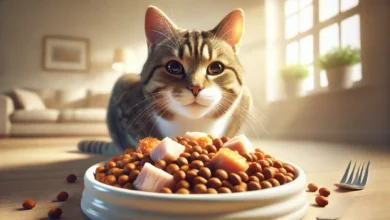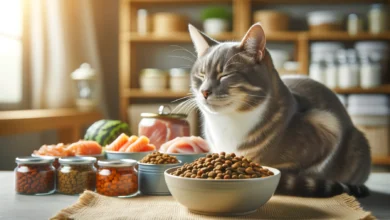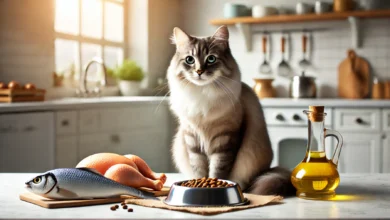Effective Tips for Weight Management in Cats
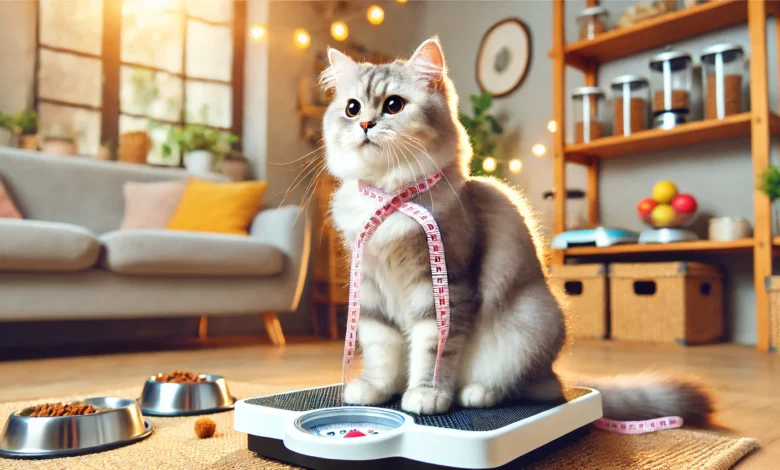
Cats are wonderful companions.
However, just like their owners, they also have problems from time to time in terms of keeping their weight healthy.
Whether it’s your cat that needs help gaining a bit more or struggling with those extra pounds, managing their weight is essential for a long and healthy life.
Weight management in cats is not just about looking good but being healthy.
This article will provide tips and strategies to help you keep your feline friend fit and active.
Maintaining your cat’s weight also reduces health risks associated with diabetes, joint problems, and heart disease.
By gaining a basic understanding of weight management and making the right choices regarding your cat’s diet and exercise, you will be helping them lead a healthier and better life.
Let’s dive into the essentials of weight management in cats and learn how you can contribute to your cat’s overall health at every step.
Table of Contents
Understanding Feline Weight Ranges
Before getting into specific diet plans and exercise routines, it’s important to understand what a healthy weight range is for your cat.
Every cat is different, and factors such as breed, age, and overall health determine what your cat should weigh.
Keeping your cat within their healthy weight range will help them avoid many of the risks associated with obesity and ensure effective weight management.
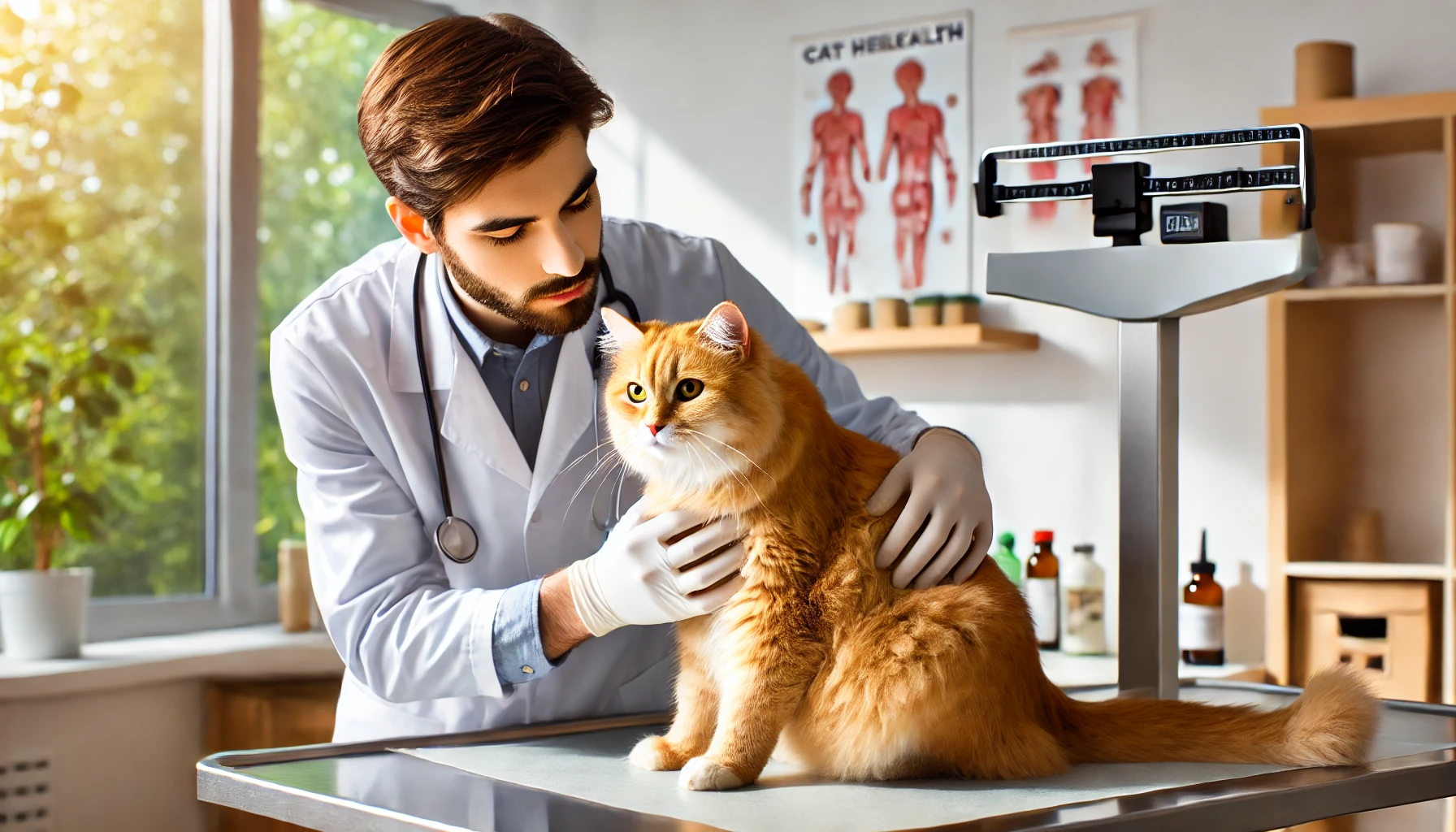
How to Know the Ideal Weight of Your Cat
The first step in weight management is determining your cat’s ideal weight.
Most domestic cats normally weigh between 8 to 10 pounds, although this can vary significantly based on breed.
For instance, larger breeds such as Maine Coons can weigh up to 18 pounds and still be considered healthy, while smaller breeds like Siamese cats may weigh between 6 to 8 pounds.
Ask your vet for a better idea of your cat’s ideal weight.
They can also provide your cat’s body condition score (BCS), which is a score based on feeling the ribs, looking for a waistline, and overall body shape.
A good BCS will place your cat in the healthy middle ground between underweight and overweight, ensuring the right balance in weight management.
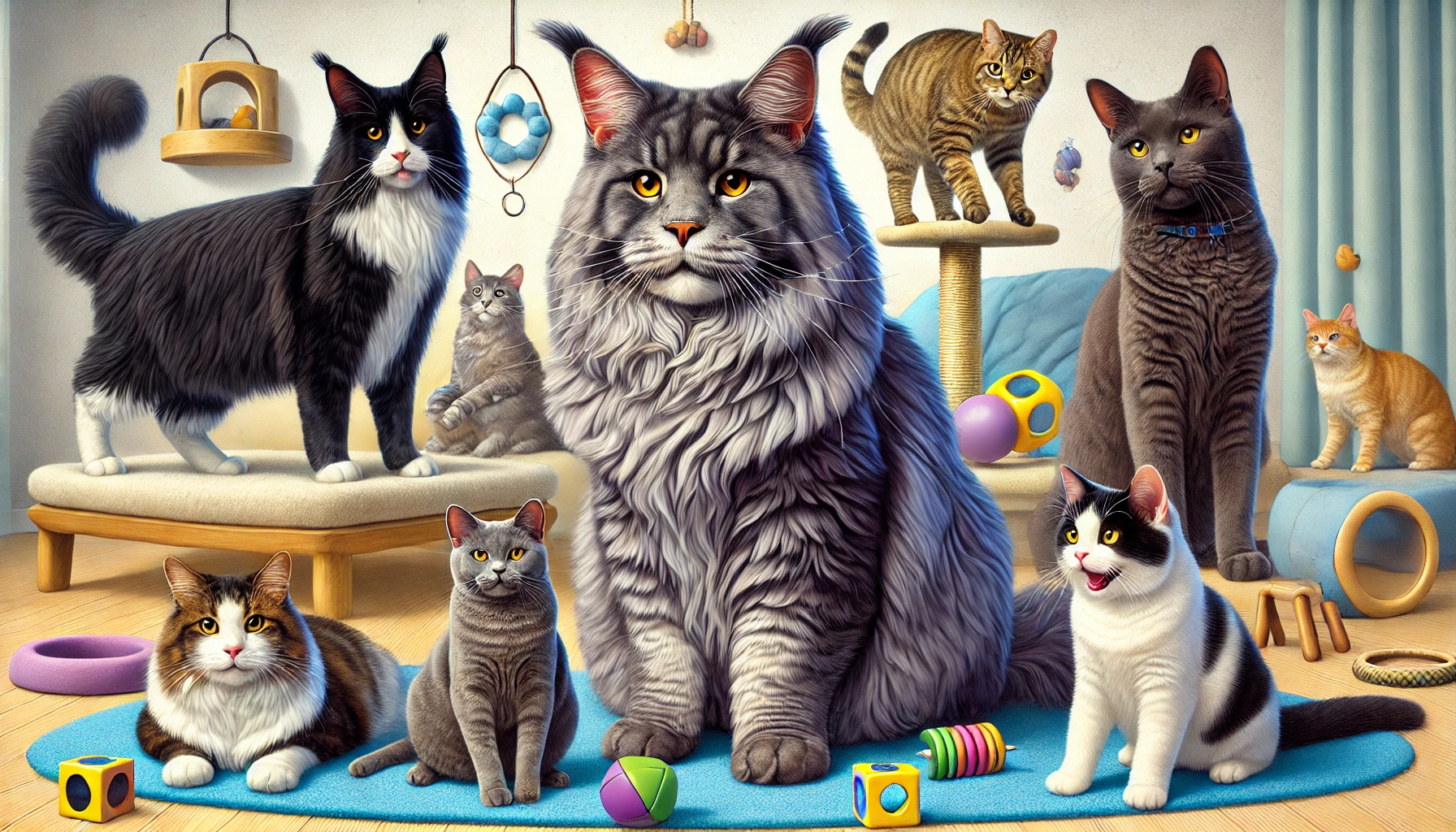
Breed-Specific Weight Considerations
Because different breeds have varying body types and genetic predispositions, breed-specific weight considerations are important in weight management for cats.
Breeds like Burmese or British Shorthair, due to their stockier build, tend to gain weight more easily, while leaner breeds like the Abyssinian are generally slimmer by nature.
Knowing these tendencies will help you tailor an approach to weight management.
If you have a breed prone to weight gain, you may need to focus on portion control and regular exercise.
On the other hand, slender breeds may require a calorie-dense diet to maintain their ideal weight.
Always take your cat’s breed into account when planning a weight management strategy.

Importance of Maintaining a Healthy Weight in Cats
Maintaining a healthy weight is extremely important for your cat’s long-term health and well-being.
Overweight cats are highly susceptible to diseases such as diabetes, arthritis, and even heart problems.
Excess weight also puts strain on their joints, making movement uncomfortable and affecting their overall quality of life.
On the other hand, underweight cats may suffer from malnutrition, a weakened immune system, and other health complications.
A balanced weight will ensure that your cat remains energetic, playful, and free from the burdens of weight-related issues.
By investing in your cat’s weight management now, you’ll not only give them a better life but also potentially extend the years you spend together.
Understanding your cat’s weight range is key to their health. Each cat’s ideal weight depends on factors like breed, age, and health status.

Nutrition and Weight Management Diets
A diet that is nutritional, yet calorie-controlled, is one of the mainstays of keeping cats at their correct weight.
Feeding incorrectly, or even overfeeding, may result in your cat gaining unnecessary weight and developing health problems.
Controlling your cat’s nutrition plays a critical role in keeping them at a healthy weight, which is essential for effective weight management.

Choosing the Correct Cat Food for Weight Management
Weight management formulas are the best diet you can choose for your kitty.
These foods contain fewer calories but provide all the necessary nutrients.
Most brands have weight-control recipes, and their branding usually includes words like ‘light’ or ‘low-calorie’.
Be sure to look for products filled with premium-grade proteins, which help your cat feel fuller and maintain lean muscle mass.
Chicken, turkey, and fish are great sources of protein to add to your cat’s weight management diet.
Here are a few things to consider when choosing weight control food for your cat:
- Read Labels: The fewer fillers, such as grains, in the food, the better. Fillers can make cats prone to weight gain.
- Choose High Protein: Cats are obligate carnivores, so a high-protein, animal-based diet keeps their energy levels up without adding extra calories.
- Opt for Wet Food: Wet cat foods generally contain fewer calories and have a higher moisture content, which helps keep your cat well-hydrated while managing their weight.
- Gradually Transition Foods: When switching to a weight-control diet, gradually introduce the new food over 7-10 days to prevent digestive upset.
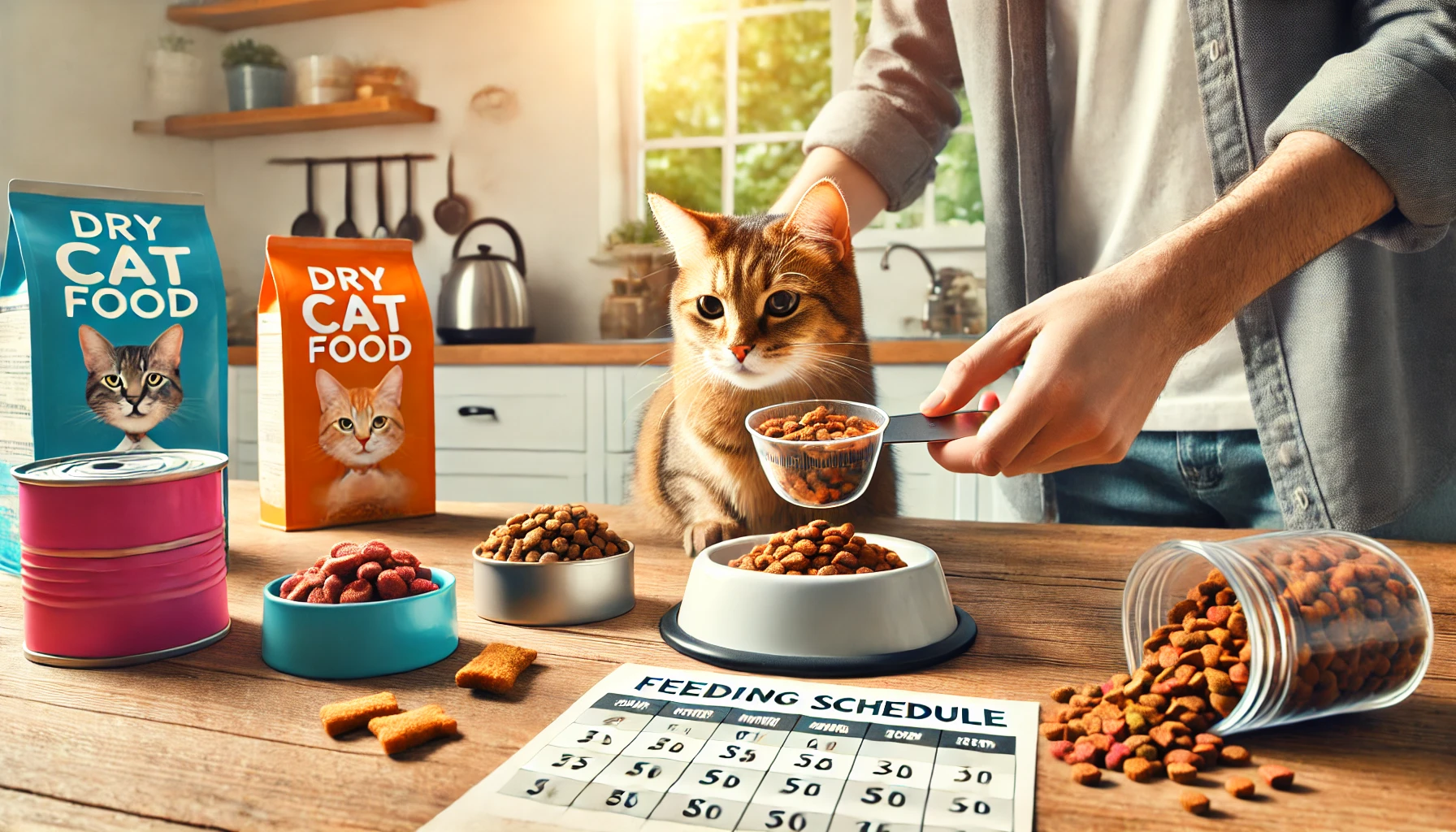
How to Measure Portion Sizes for Cats
Not overfeeding is just as important as choosing the right food.
Even overfeeding healthy food can lead to unwanted weight gain.
Cats, especially those who are free-fed (meaning food is always available), can be prone to overeating.
Instead, use measured portions so they eat the correct amount, considering their size and activity level.
Here’s how to measure your cat’s portions effectively:
- Consult Your Vet: Ask your vet to recommend your cat’s daily caloric needs based on their ideal weight.
- Follow Feeding Guidelines: Most cat food packaging includes feeding guidelines based on your cat’s weight. Stick to these guidelines or adjust according to your vet’s advice.
- Use a Measuring Cup: Always measure dry food with a standard cup to avoid overfeeding.
- Divide Meals: Split your cat’s meals into smaller portions throughout the day to avoid overeating in one sitting.
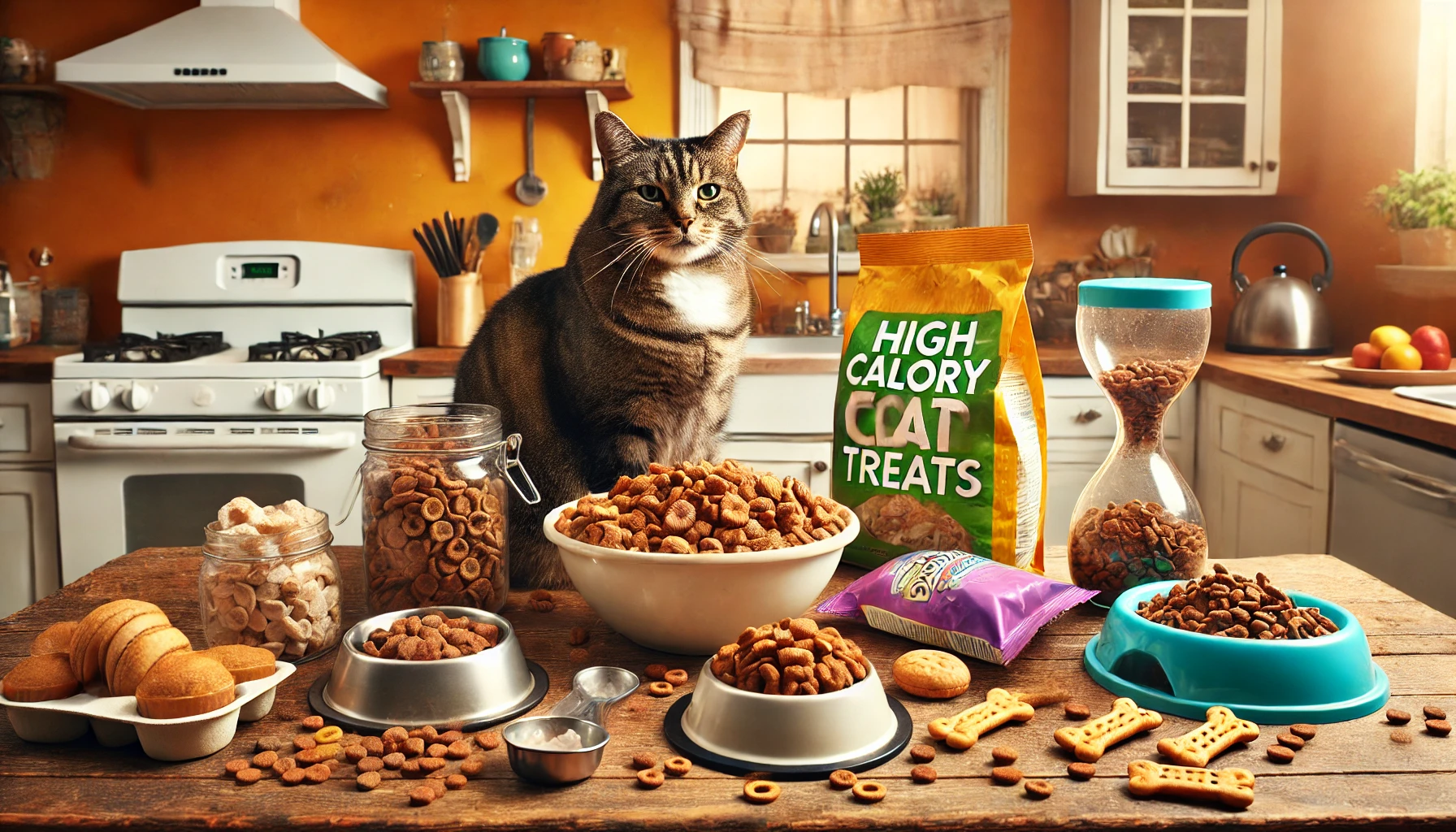
Common Food Mistakes That Can Lead to Weight Gain
Even the most well-meaning cat owners make mistakes when managing their cat’s diet.
Knowing these common errors can help you avoid them and keep your cat on track with their weight management.
- Overindulging in Treats: It’s easy to reward your cat with treats, but extra calories can add up quickly. Limit treats and choose healthier, low-calorie options.
- Table Scraps: Human food has no nutritional value for cats and can contribute to obesity and other health issues. Avoid feeding your cat table scraps.
- Not Paying Attention to Portions: Free-feeding or offering more than the recommended portion size can lead to overeating in a short time.
- Inconsistent Feeding: Establish a consistent feeding routine and avoid giving treats or snacks between meals.
By selecting the right food, managing portions, and avoiding common feeding mistakes, you can effectively manage your cat’s weight and help them live a healthier life.
Choosing a balanced, calorie-controlled diet for your cat helps maintain their healthy weight. Always consider the quality of ingredients in their food.
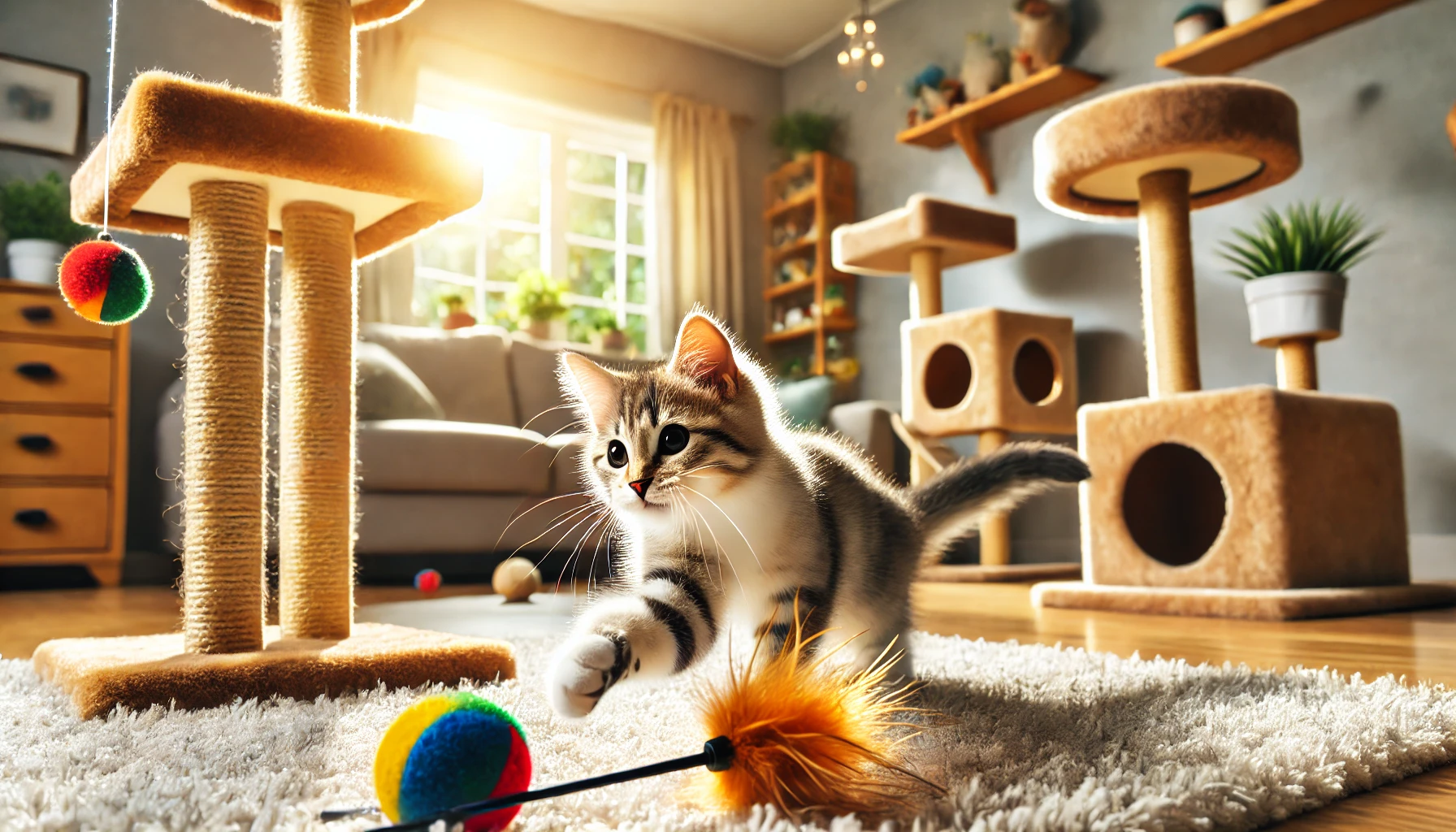
Exercise and Activity for Weight Management in Cats
While nutrition plays a major role in weight management for cats, exercise and activity levels are equally crucial.
Regular physical activities burn off excess calories, build muscle, and keep your cat mentally stimulated.
Most domesticated cats lead more sedentary lifestyles, which can result in significant weight gain.
Ensuring your cat gets enough exercise is essential for keeping them healthy and at an ideal weight.
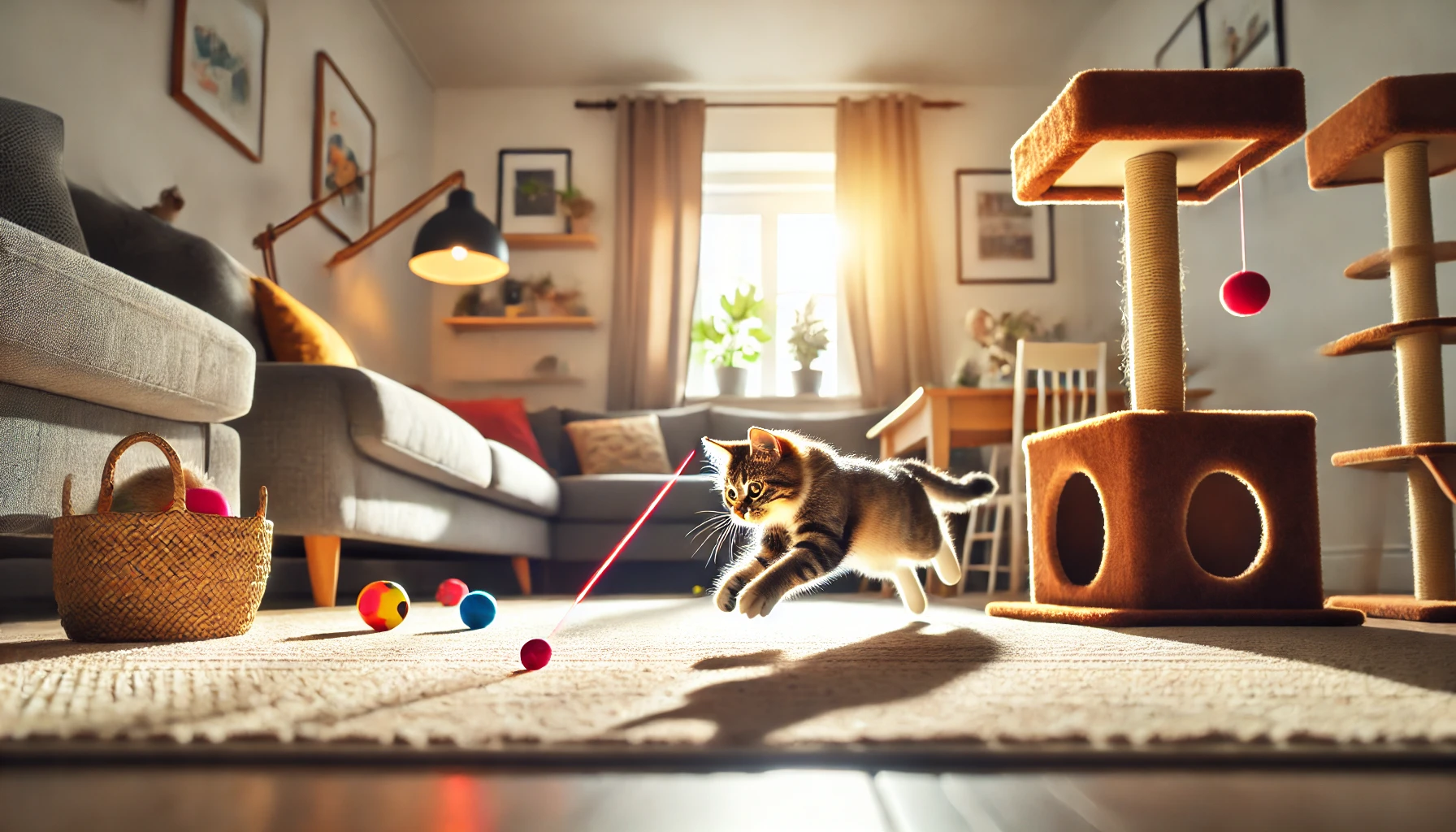
Engaging Your Cat in Active Play
Cats are natural predators, and engaging in active play is one of the most effective ways to help your cat burn calories while satisfying their instincts.
Whether through interactive toys or chasing laser pointers, regular playtime keeps your cat moving and energized.
Aim to spend at least 15-30 minutes daily playing with your cat to keep them active and healthy.
Here are some ideas for keeping your cat active:
- Interactive Toys: Feather wands and motorized mice encourage your cat to chase, pounce, and run, mimicking hunting behavior.
- Laser Pointers: Laser pointers can stimulate your cat’s hunting instincts. They will run and leap to catch the red dot. Be sure to end the session with a toy they can physically catch to prevent frustration.
- Cat Trees and Climbing Furniture: Vertical spaces like cat trees or shelves encourage climbing, which is a great form of exercise.
- Food Puzzles: Use food-dispensing toys or puzzle feeders during mealtime to engage your cat both mentally and physically while they work for their food.
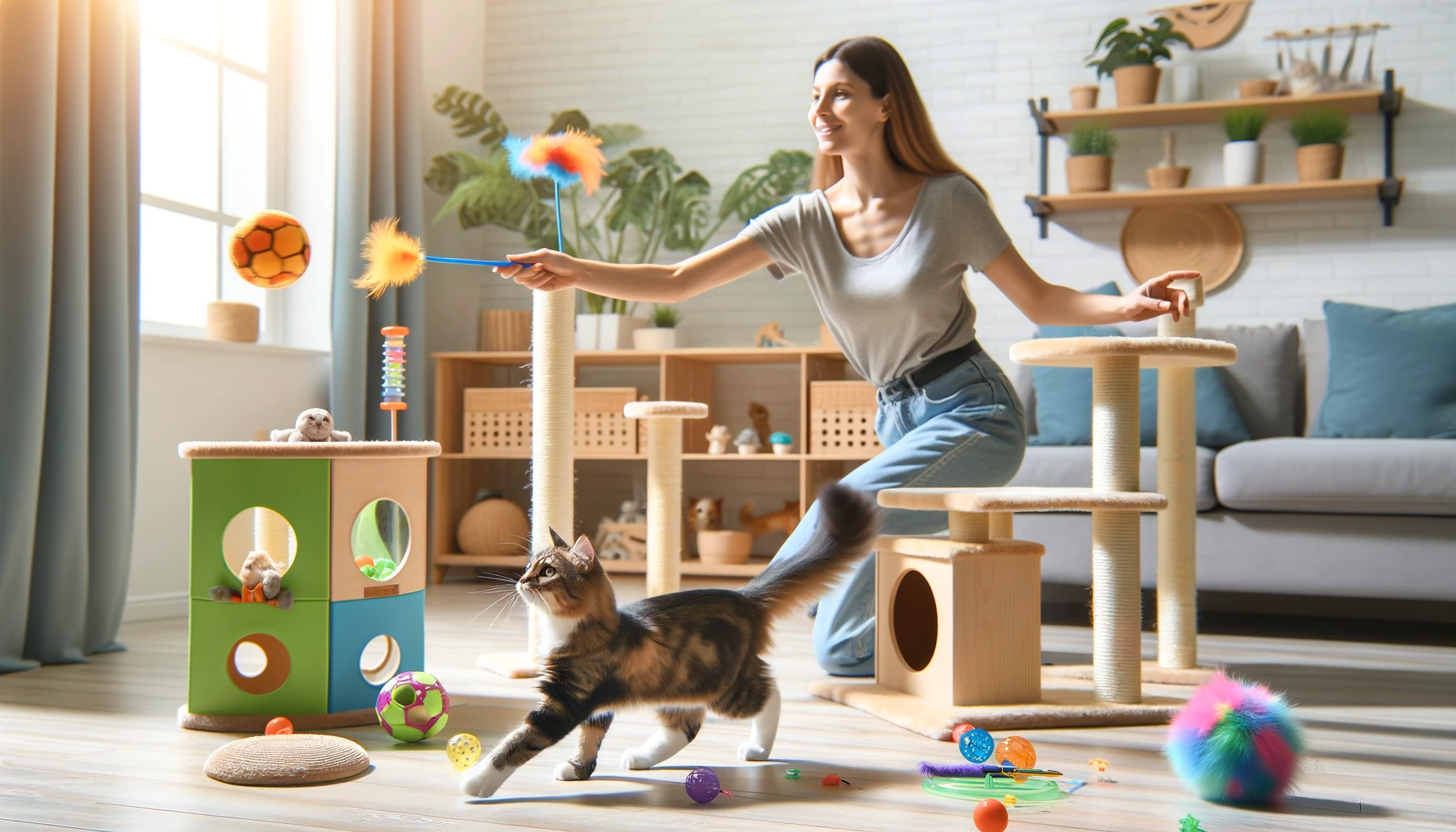
Creating a Fun Exercise Routine for Cats
Establishing a daily exercise routine is an excellent way to manage your cat’s weight.
Keeping it fun and light-hearted will ensure your cat enthusiastically participates.
Mixing activities will prevent boredom and provide both physical and mental stimulation.
Here are some tips to ensure an effective exercise routine:
- Playtime Routine: Set aside dedicated time each day for play. Cats are creatures of habit and will quickly learn when to expect playtime.
- Rotate Toys: Switch out toys weekly to prevent your cat from becoming indifferent to the same toys.
- Add Training: Teach your cat to fetch or jump through a hoop, adding variety to their routine and incorporating more physical activity.
- Encourage Exploration: Create new routes around your home and hide toys or treats to encourage your cat to explore, keeping them mentally and physically active.
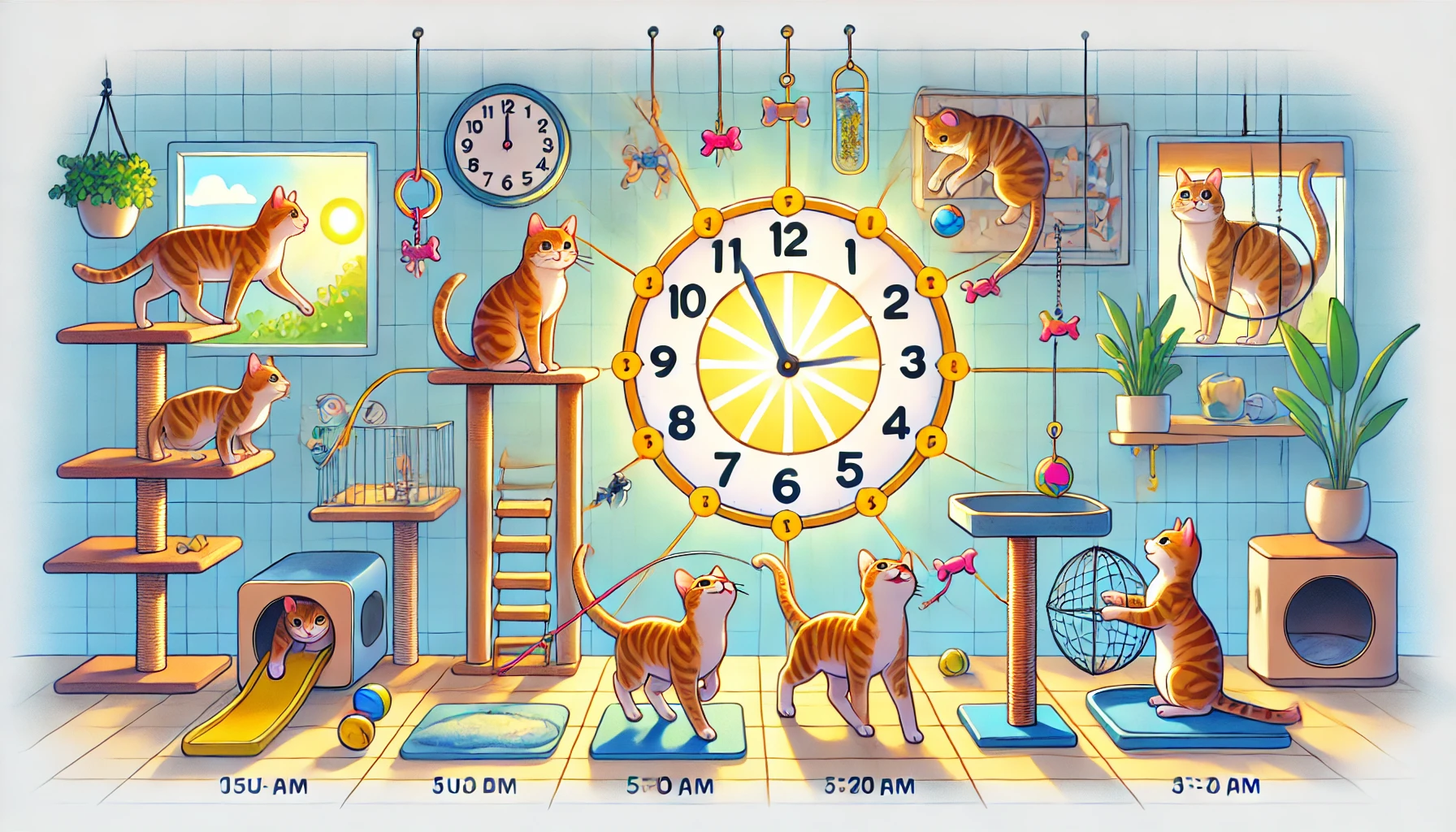
How Much Exercise Does a Cat Need Daily?
Just like humans, a balance between diet and exercise is essential for weight management in cats.
While each cat is unique, the general recommendation for healthy adult cats is at least 15-30 minutes of exercise per day.
More active breeds or individual cats may require more exercise to maintain an ideal weight.
If your cat is overweight, it’s best to gradually increase their activity level to avoid putting strain on their joints.
Start with shorter, light play sessions and build up to longer exercise periods.
Always consult your vet for personalized advice on your cat’s exercise needs.
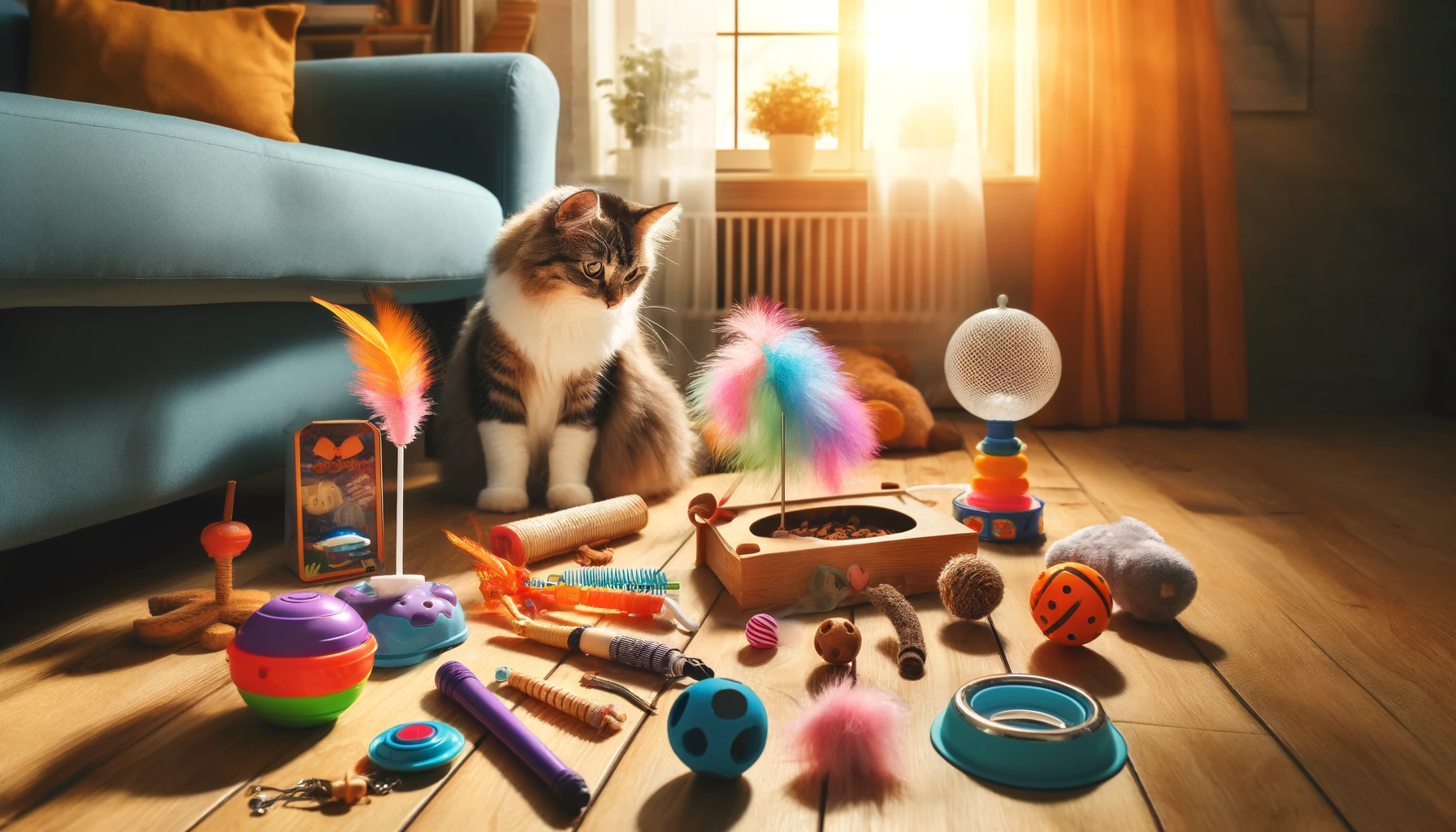
Using Toys and Tools to Encourage Activity
There are many toys and tools designed to keep cats active and engaged.
From simple DIY solutions to high-tech gadgets, these tools can make exercise more enjoyable for your cat.
- Automatic Laser Toys: These toys move the laser around randomly, keeping your cat engaged even when you’re not available to play.
- Interactive Ball Toys: Motion-activated balls roll around, enticing your cat to chase them.
- Cat Tunnels: Tunnels encourage running, hiding, and pouncing, providing both physical exercise and mental stimulation.
- Feathered Toys: Feathered toys mimic birds in flight, which is irresistible to cats. These toys are perfect for chasing and jumping exercises.
Incorporating these physical activities into your cat’s daily routine is crucial for effective weight management.
Keeping your cat active will help them stay healthy, energetic, and maintain a healthy weight.
Regular physical activity is essential for your cat’s weight management. Engage them in daily play and activities to help burn excess calories.
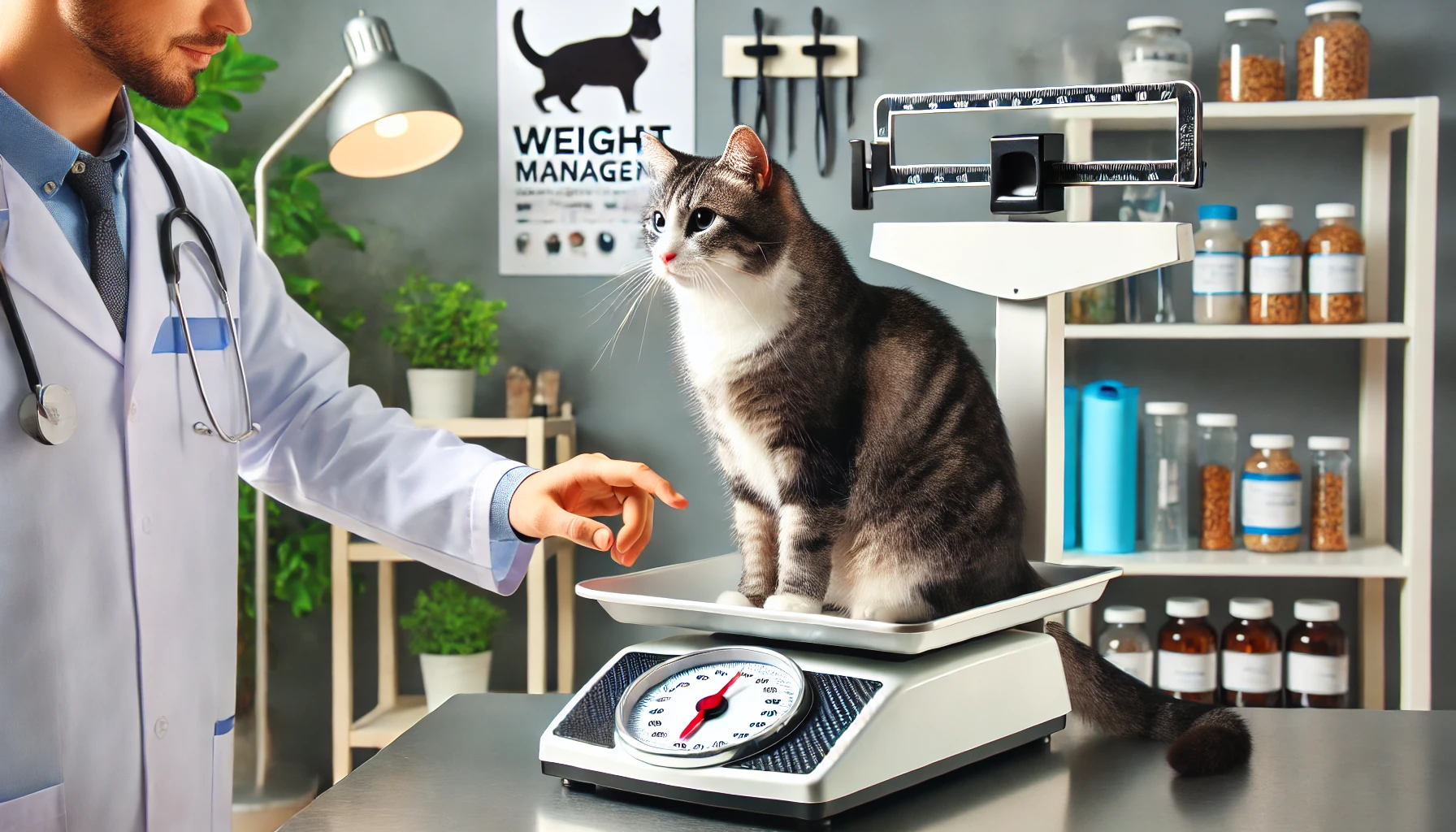
Weight Checking and Alteration of Your Cat’s Weight
Checking your cat’s weight is a crucial part of weight management for cats.
This includes periodic weigh-ins and adjusting their diet and physical activity if their weight falls below or exceeds the healthy range.
Regular weight monitoring helps detect any potential issues early, preventing serious health problems and allowing you to make the necessary adjustments to maintain your cat’s overall health and well-being.
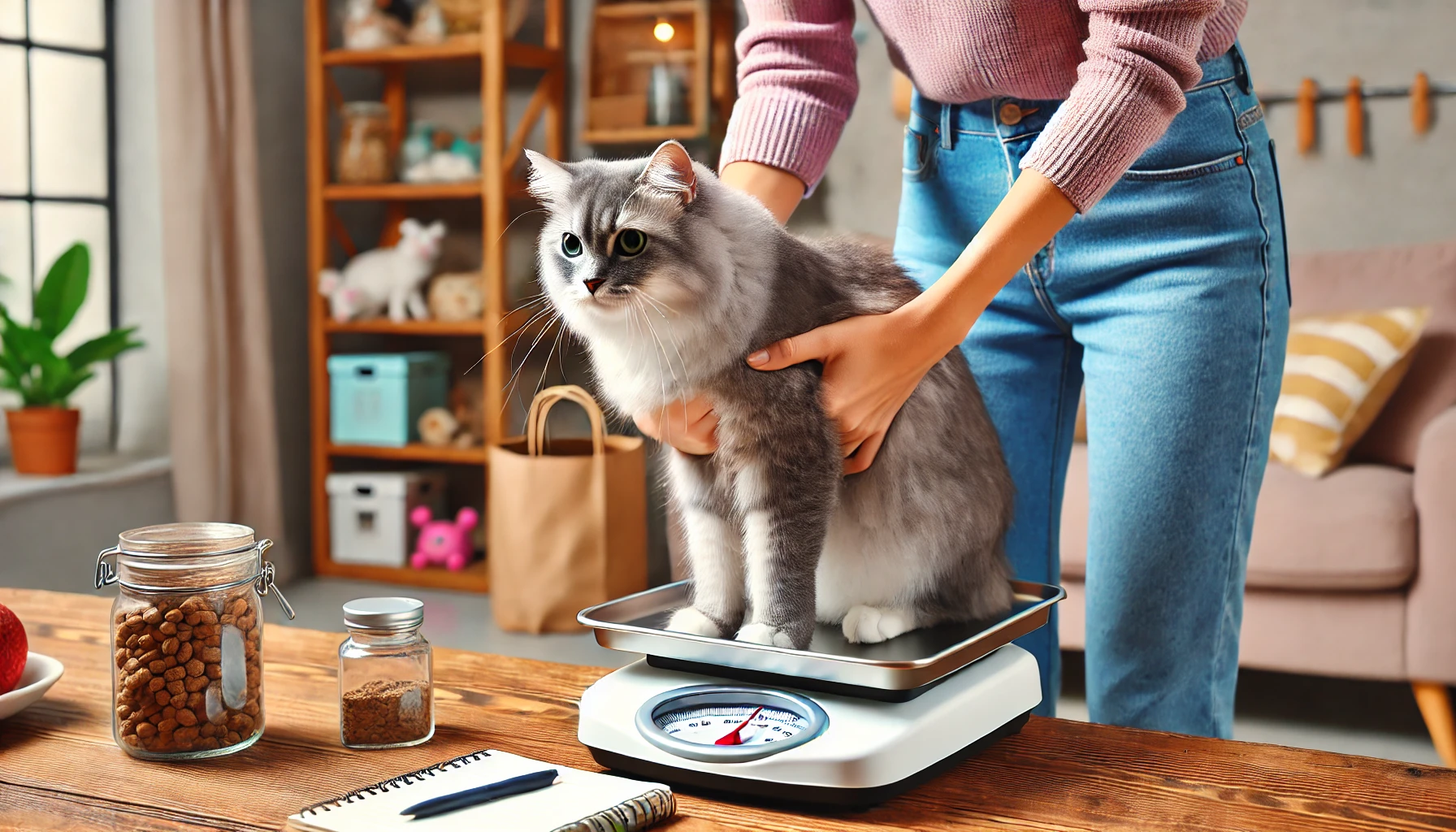
How to Monitor Your Cat’s Weight
The best way to manage your cat’s weight is to monitor it over time.
You can do this using a household scale or by regularly weighing them at your vet’s office.
Weighing your cat every 2 to 4 weeks will give you a clear picture of whether your cat is losing, gaining, or maintaining their current weight.
Here are some ways you can monitor your cat’s weight:
- Weigh Your Cat at Home: Simply weigh yourself on a bathroom scale while holding your cat, then subtract your weight to get their weight.
- Monitor Body Condition: In addition to weighing, check your cat’s body condition regularly by feeling their ribs and checking their waistline. Cats should have a slight indentation behind the ribs when viewed from above.
- Weight Log: Record your cat’s weight each time you weigh them. This will help you observe trends and make any necessary adjustments.
- Veterinary Care: Regular vet visits provide a professional evaluation of your cat’s weight and body condition. Your veterinarian can offer expert advice on weight management based on their findings.
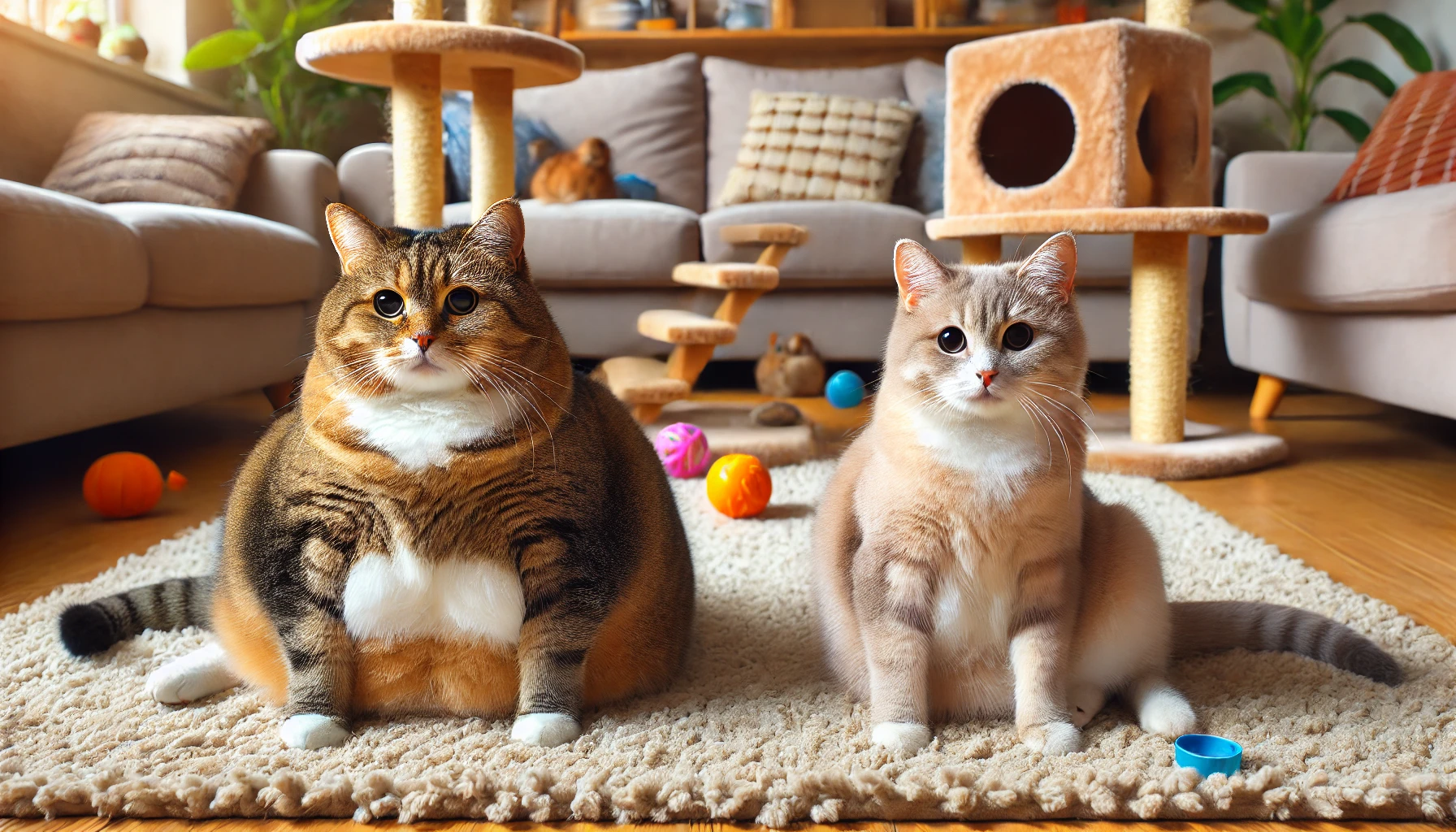
Signs of Overweight or Underweight Cats
Knowing whether your cat is overweight or underweight is essential for proactive weight management.
While the scale provides numbers, their physical appearance and behavior also offer crucial insights into their health.
Signs your cat may be overweight:
- Difficulty feeling their ribs when you gently press on their sides.
- Visible fat deposits on the abdomen, face, or limbs.
- Lack of a visible waistline when viewed from above.
- Lethargy or avoidance of physical activity.
Signs your cat may be underweight:
- Ribs, spine, or hip bones that are easily felt with minimal pressure.
- Lack of fat covering on their body.
- A waistline that appears too narrow or sunken when viewed from above.
- Low energy levels or reduced activity.
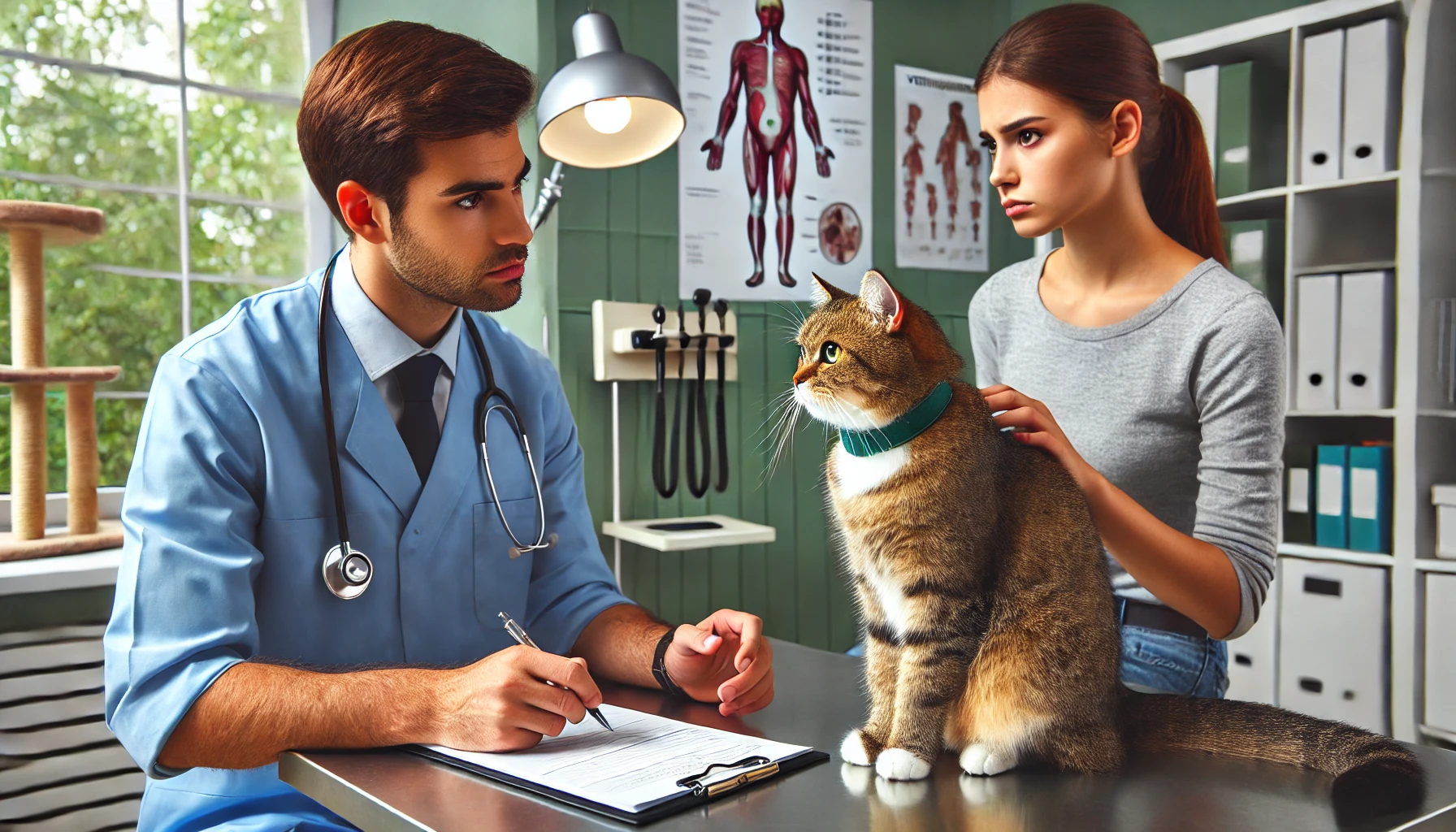
When to Call a Vet About Your Cat’s Weight
It’s always a good idea to consult your vet whenever you notice sudden changes in your cat’s weight, whether they are gaining or losing weight.
Sometimes, weight changes can be caused by underlying health problems like hyperthyroidism, diabetes, or digestive issues.
Your vet can rule out medical conditions with diagnostic tests and provide advice on a proper weight management plan.
If your cat is struggling to lose weight or appears underweight, your veterinarian may recommend special diets, supplements, or other treatments to help bring their weight back into the healthy range.
A professional opinion is invaluable in addressing any underlying health problems and keeping your cat at an ideal weight.
Monitoring your cat’s weight regularly ensures you catch any issues early and adjust their diet or exercise plan accordingly.
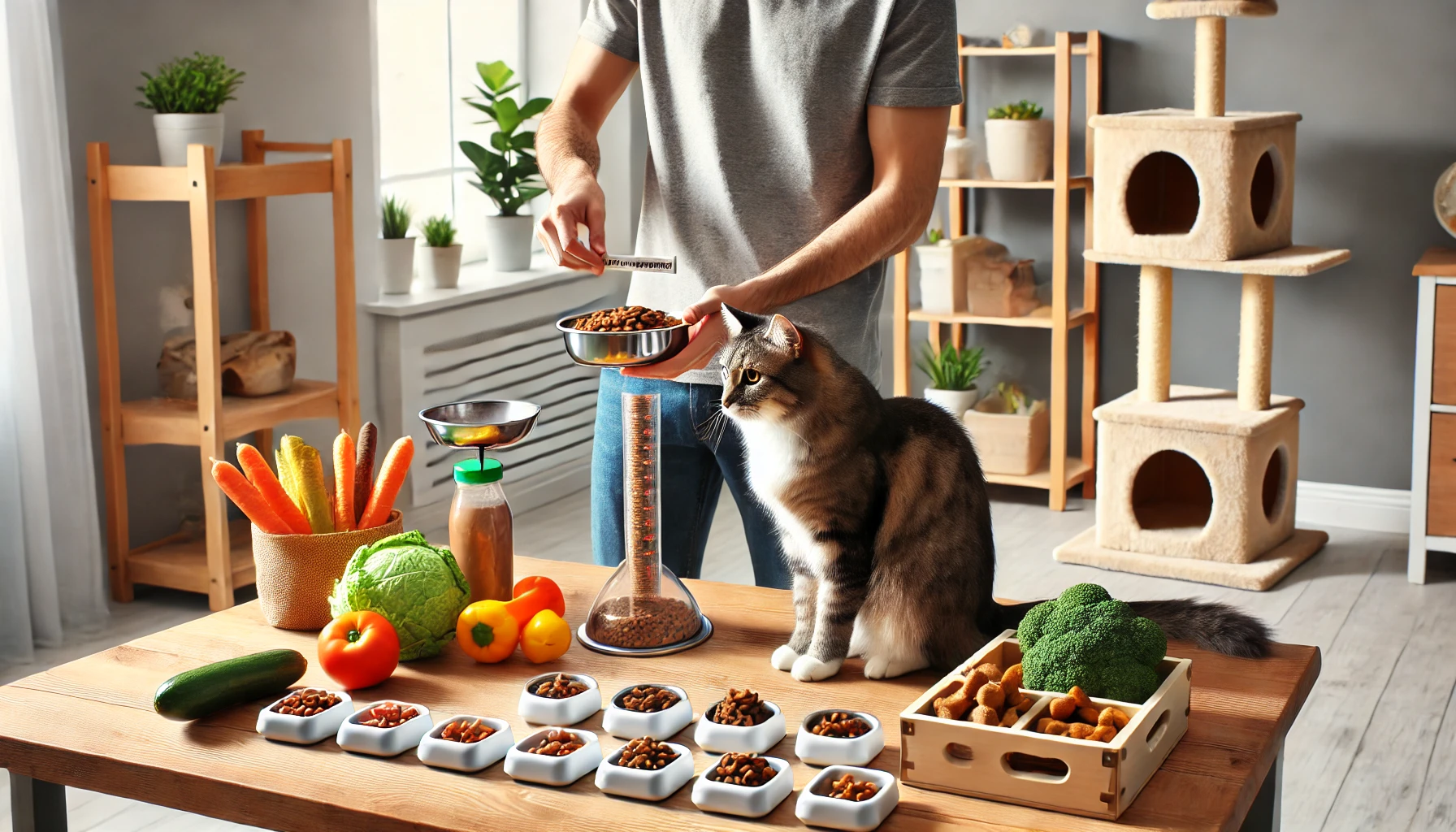
Preventing Weight Problems in Cats
It’s always better to prevent than to cure, and this is especially true when it comes to weight management for cats.
You can help your cat maintain an ideal weight throughout their life by taking precautionary measures.
Preventing weight gain from the start can save your cat from numerous health problems and keep them energetic and lively.
Taking steps to prevent weight issues is essential for every cat owner.
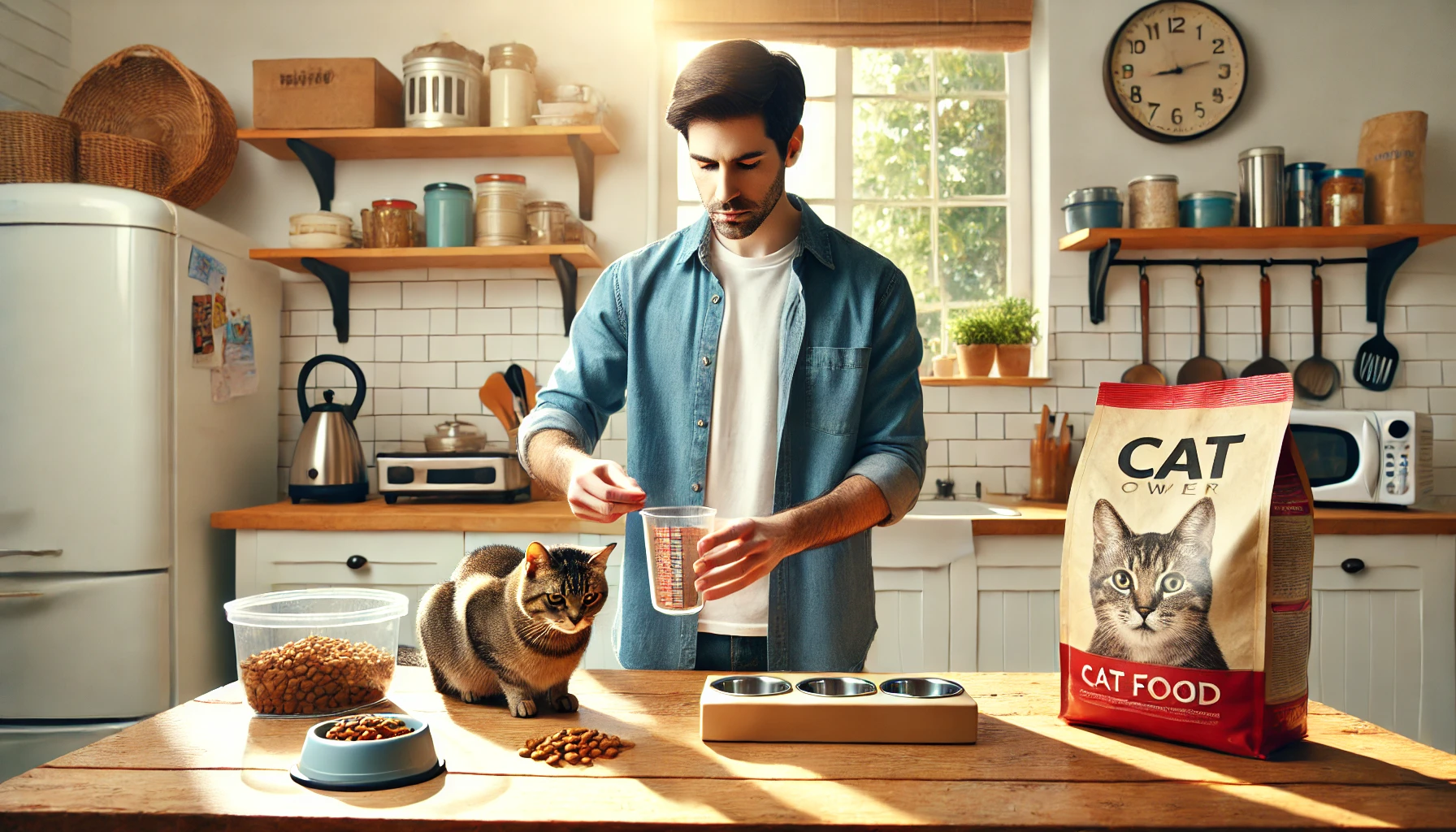
How to Avoid Overfeeding
Overfeeding is one of the most common causes of feline weight gain.
Free-feeding or giving in to your cat’s constant begging for treats can easily lead to your cat consuming more calories than they need.
This is why scheduled feeding and portion control are the best options for managing their weight.
Here are some useful tips to avoid overfeeding:
- Scheduled Feeding: Feed your cat at set times each day instead of leaving food out all the time to prevent overeating.
- Measure Portions: Always use a measuring cup to ensure you are providing the correct portion size based on your cat’s weight and needs.
- Limit Treats: Treats are great for rewarding your cat, but too many can add unnecessary calories. Choose low-calorie treats and limit the number you give each day.
- Keep an Eye on Leftovers: If your cat consistently leaves food behind, you may be feeding too much. Reduce their portion sizes to avoid waste and overfeeding.
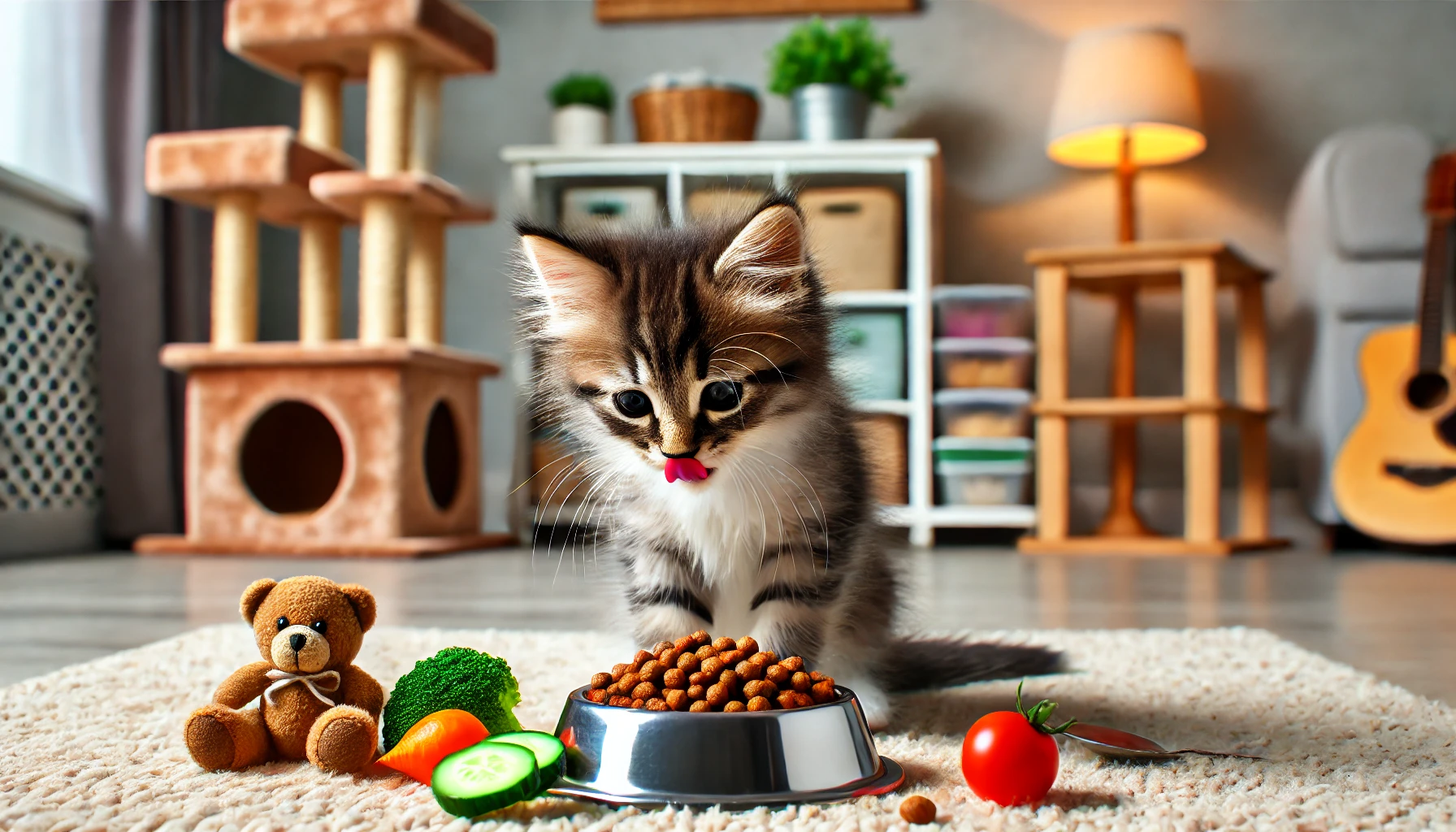
Stabilizing an Early Diet
Setting up a proper diet during your cat’s early years goes a long way in preventing weight problems.
Cats that are fed a nutritionally balanced diet, including appropriate amounts of protein, fat, and carbohydrates, are more likely to maintain a healthy weight throughout their life.
Here’s how to give your cat a balanced diet:
- High-Quality Protein: Since cats are obligate carnivores, a diet rich in animal-based protein is essential for maintaining lean muscle mass and supporting overall health.
- Avoid Empty Calories: Some cat foods contain fillers like grains and by-products that are unnecessary for your cat and may contribute to weight gain. Choose nutrient-dense, high-quality foods that offer the right balance of nutrients without extra calories.
- Think Wet Food: Wet food contains more moisture and fewer calories, making it a great choice for cats that need to control their weight.
- Monitor Caloric Intake: Regularly monitor your cat’s caloric intake to ensure they do not exceed their daily requirements.
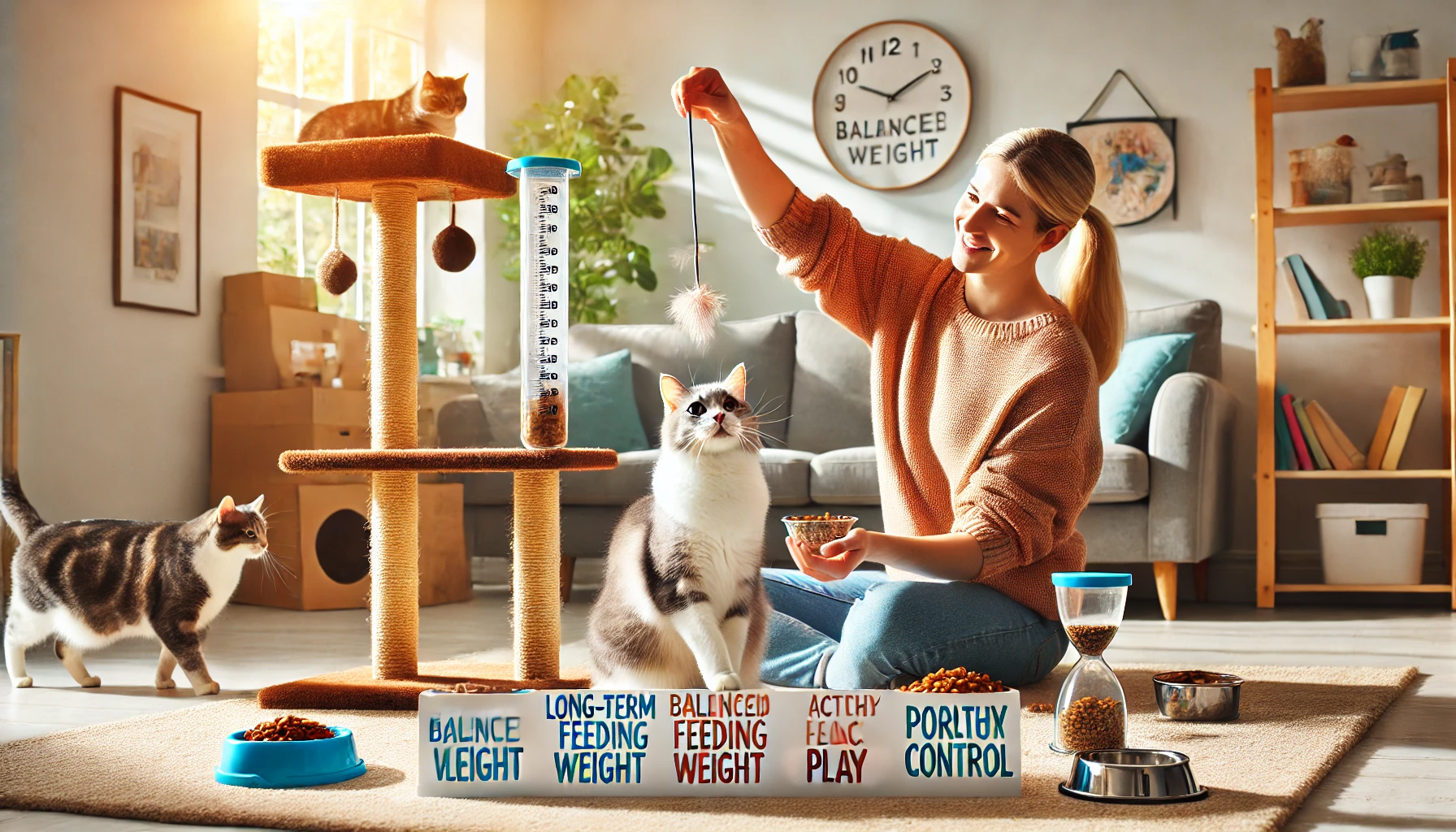
Long-Term Tips for Maintaining a Healthy Cat Weight
Weight management is a lifelong commitment.
By following these long-term strategies, you can ensure your cat maintains a healthy weight throughout their life.
Long-term weight management strategies include:
- Be Consistent: Consistency in feeding times, portion control, and exercise routines will help keep your cat at their ideal weight.
- Encourage Regular Activity: Ensure your cat gets daily exercise and exploration opportunities to stay active, burn excess calories, and prevent weight gain.
- Monitor Weight Regularly: Regularly weighing your cat helps you detect any weight changes early and make timely adjustments to their diet or activity level.
- Visit the Vet: Regular veterinary checkups help ensure your cat remains healthy and maintains a proper weight. Your vet can also offer personalized recommendations for weight management.
By providing a proper diet, avoiding overfeeding, and encouraging regular activity, you can effectively prevent weight issues in your cat and help them live a long and healthy life.
Preventing weight problems from the start will save your cat from health issues. Consistency in diet and exercise is crucial.
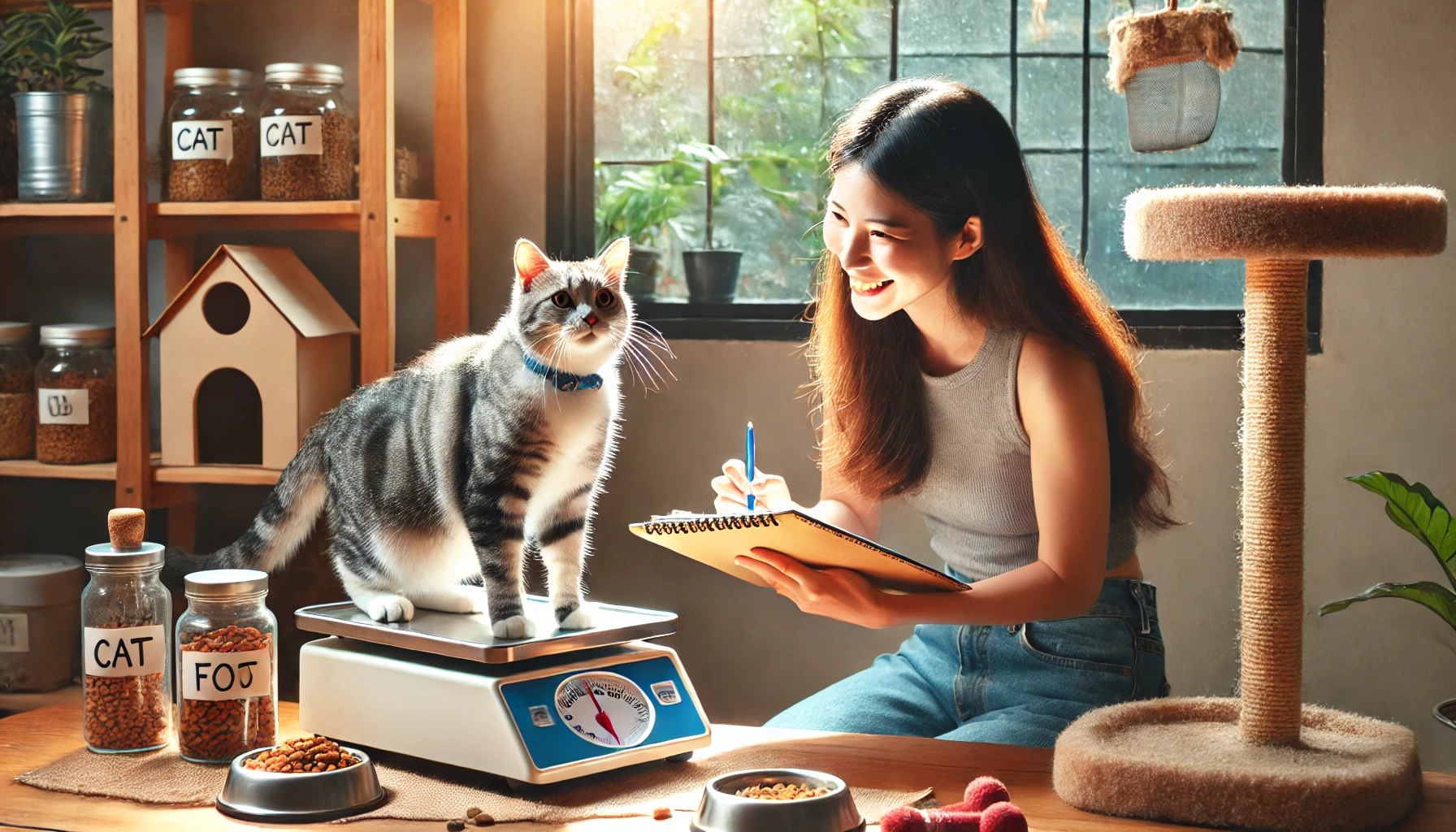
Ensuring Weight Management Success in Cats
Weight management for cats is a critical component of maintaining your cat’s overall health.
Effective weight management helps your cat stay active, happy, and free from disease.
Throughout this article, we have discussed various strategies and tips to ensure your cat stays at their ideal weight, from choosing the right diet to incorporating regular physical activity.
By taking preventive steps, you can avoid weight-related health conditions and ensure your cat enjoys a healthy and fulfilling life.
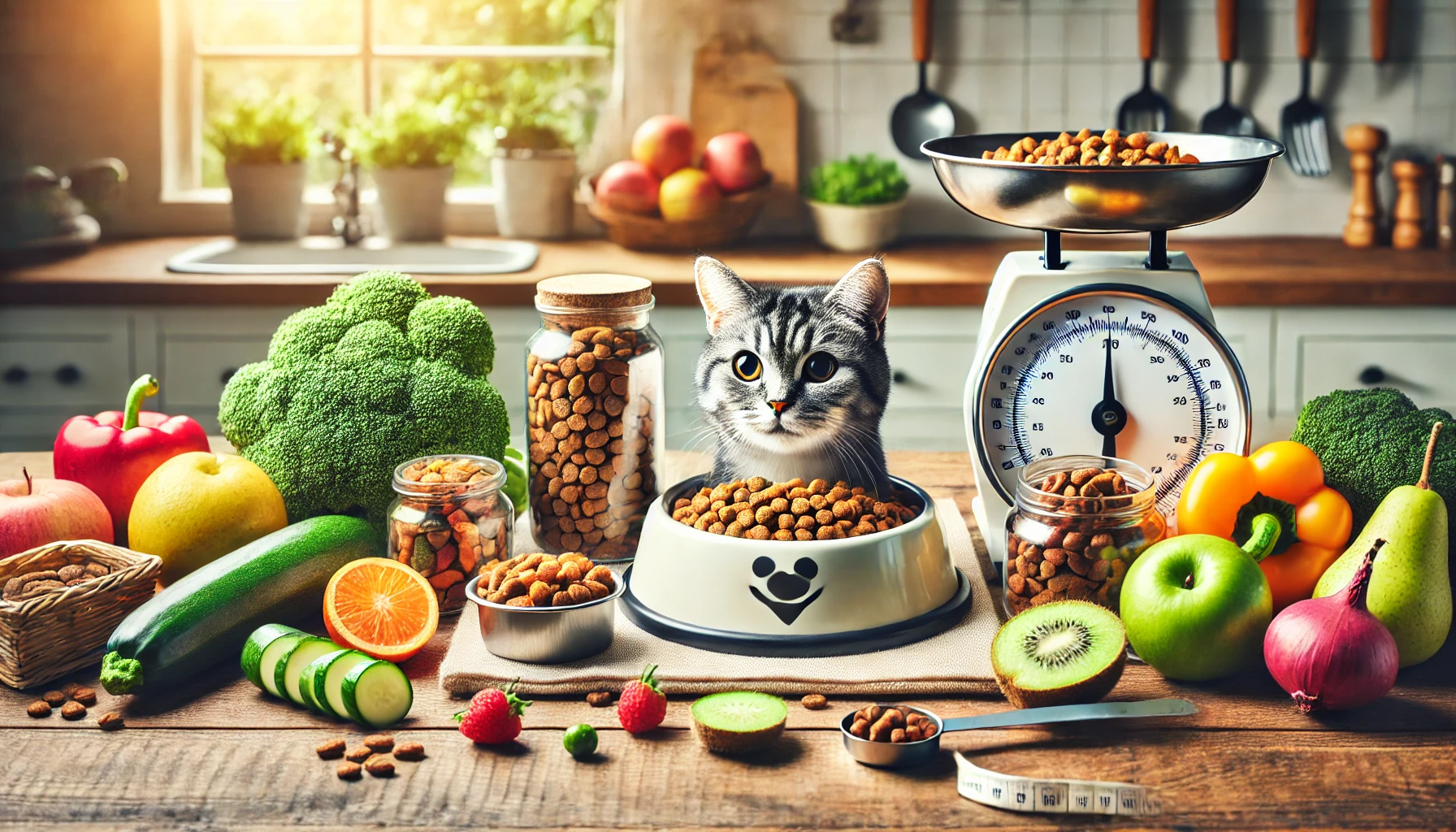
Nutritional Balance and Control of Portions
Nutrition is the cornerstone of feline weight management.
By selecting high-quality, nutrient-dense food that meets your cat’s dietary needs without adding excess calories, you set them up for success.
Portion control is equally important, as overfeeding is one of the most common causes of weight gain.
Monitoring how much your cat eats ensures they receive the appropriate number of calories based on their weight and activity level.
Key points to remember:
- Use high-quality, protein-based cat food designed for weight management.
- Measure portions accurately to prevent overfeeding.
- Limit treats, but opt for low-calorie treats when rewarding your cat.
- Consider wet food, which tends to have fewer calories and more moisture.
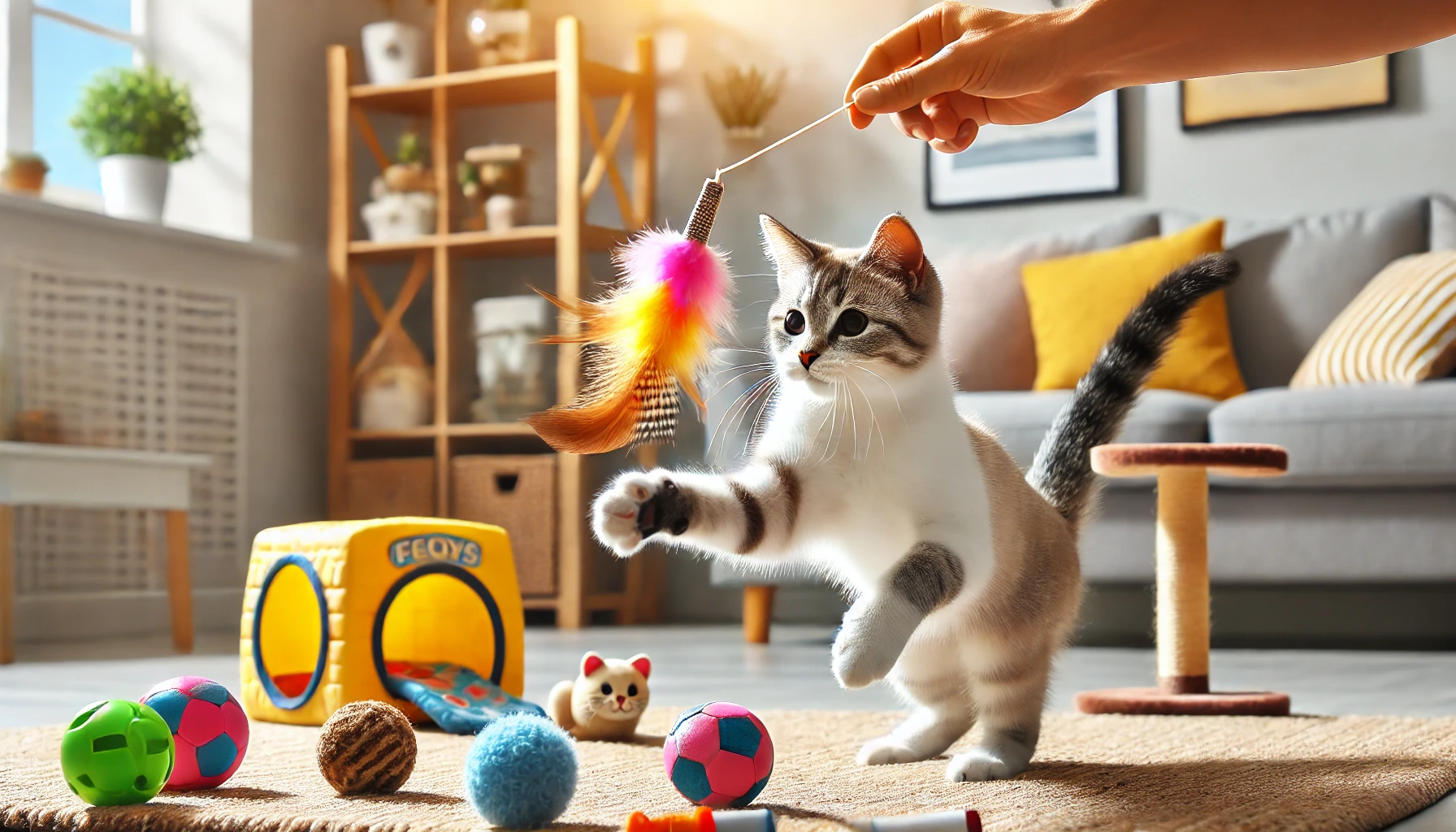
The Role of Exercise and Activity
Exercise is another vital component in managing weight for cats.
Regular physical activity not only helps burn surplus calories but also provides mental stimulation and keeps your cat engaged.
Establishing a daily exercise routine and providing toys or tools that promote activity will significantly contribute to keeping your cat at an ideal weight.
Important reminders:
- Play with your cat for at least 15-30 minutes each day using interactive toys.
- Rotate toys frequently to maintain mental and physical stimulation.
- Allow your cat access to vertical spaces, such as cat trees, to encourage climbing and movement.
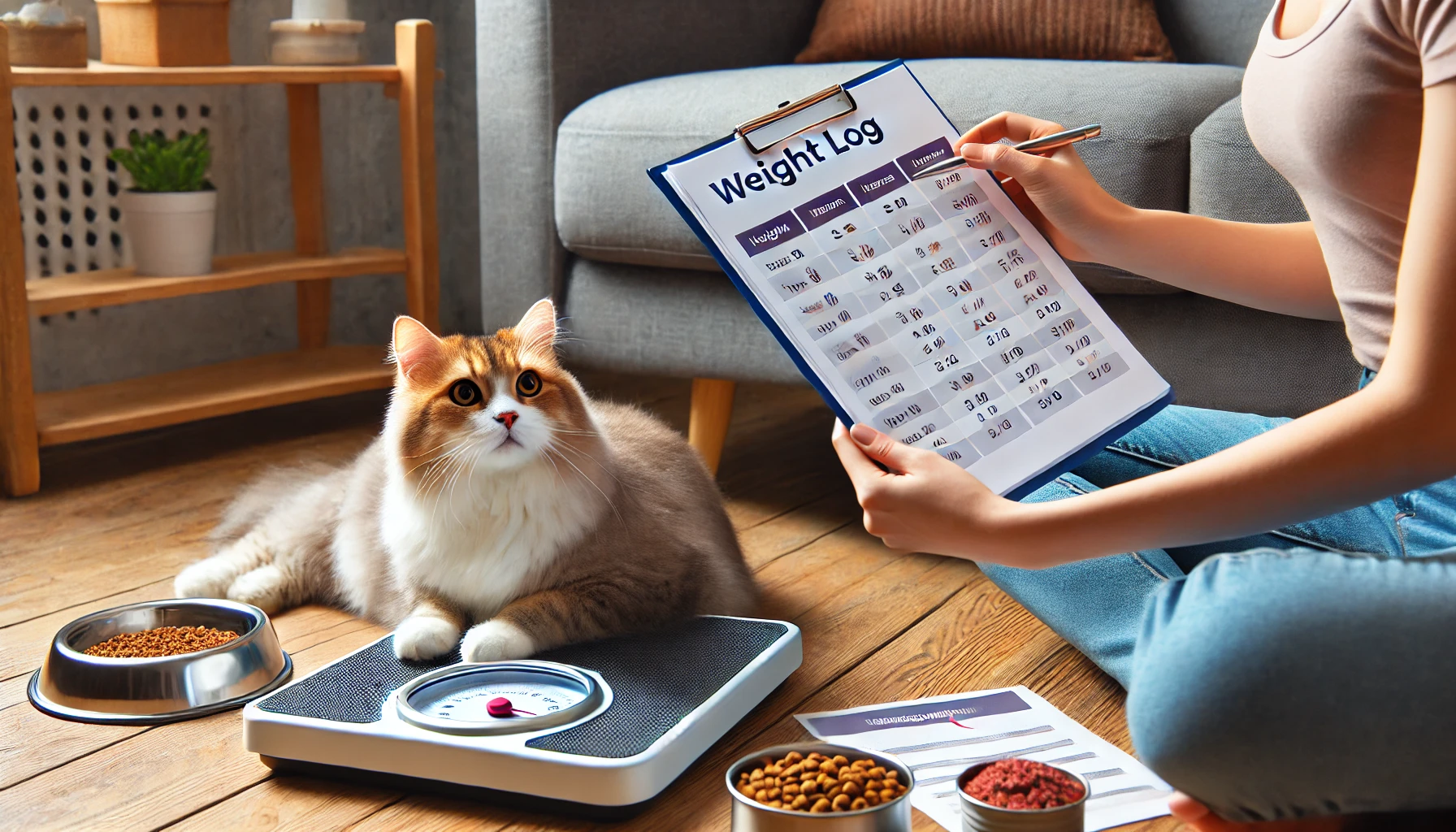
Regular Monitoring and Adjustments
One of the most effective ways to manage your cat’s weight is through regular monitoring.
Weighing your cat every 2 to 4 weeks helps you track any changes in weight and adjust their diet or exercise routine accordingly.
Keeping a weight log and consulting with your vet ensures you are on the right track to maintaining your cat’s ideal weight.
Steps to follow:
- Weigh your cat periodically to monitor weight changes.
- Check your cat’s body condition by feeling for their ribs and waist.
- Keep a weight log to observe trends and make necessary adjustments.
- Schedule regular vet check-ups for professional advice on weight management.
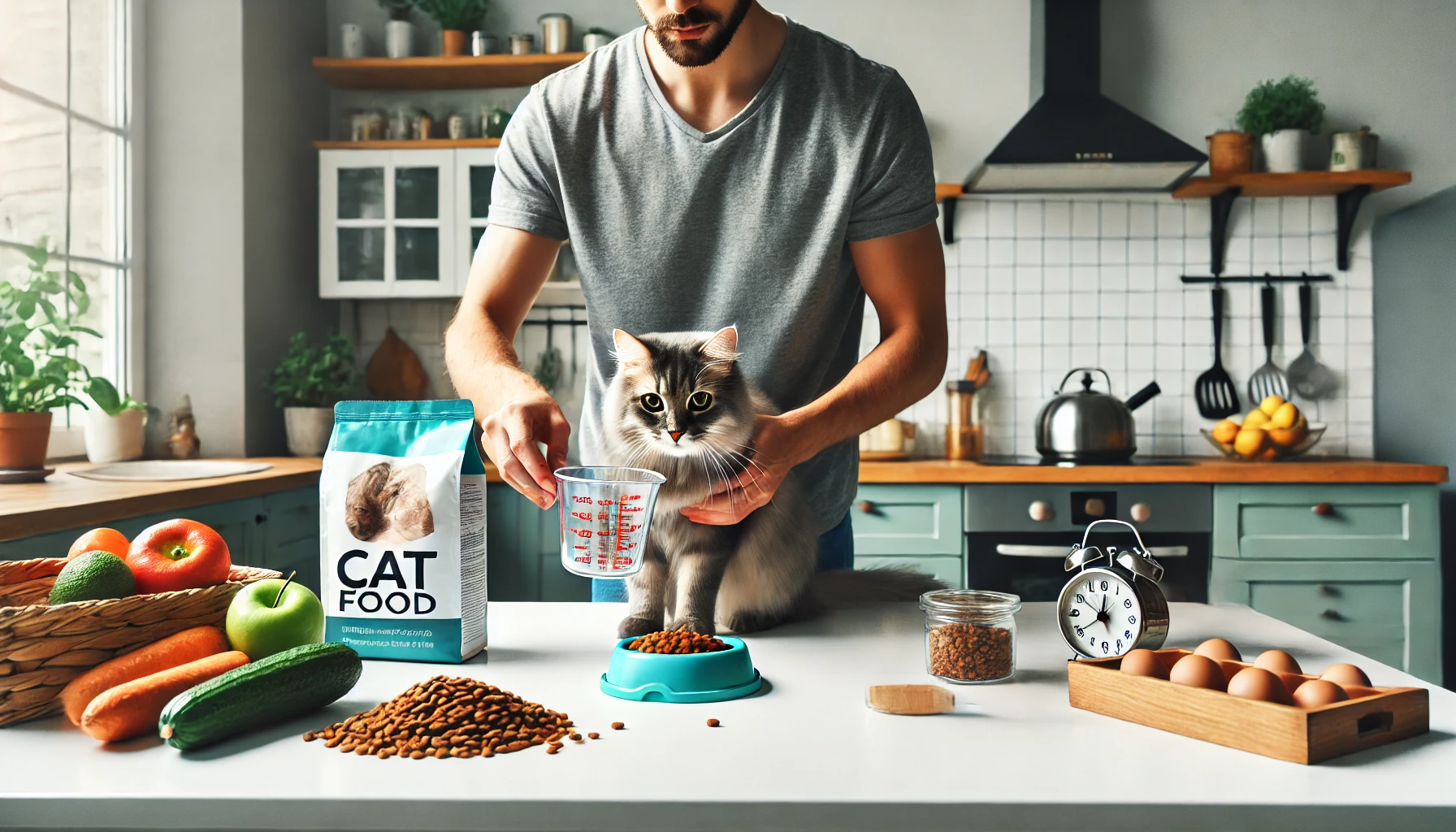
Prevention is Better than Cure
It is much easier to prevent weight gain than to address it after the fact.
By establishing good habits early, including proper diet, regular exercise, and monitoring your cat’s weight, you can avoid many of the health complications associated with obesity.
Long-term tips for success:
- Be consistent with feeding times, portion sizes, and exercise routines.
- Provide your cat with ways to stay active by offering toys and opportunities for exploration.
- Monitor your cat’s weight regularly and adjust their routine as needed.
- Schedule regular vet visits for professional guidance on maintaining your cat’s health and weight.
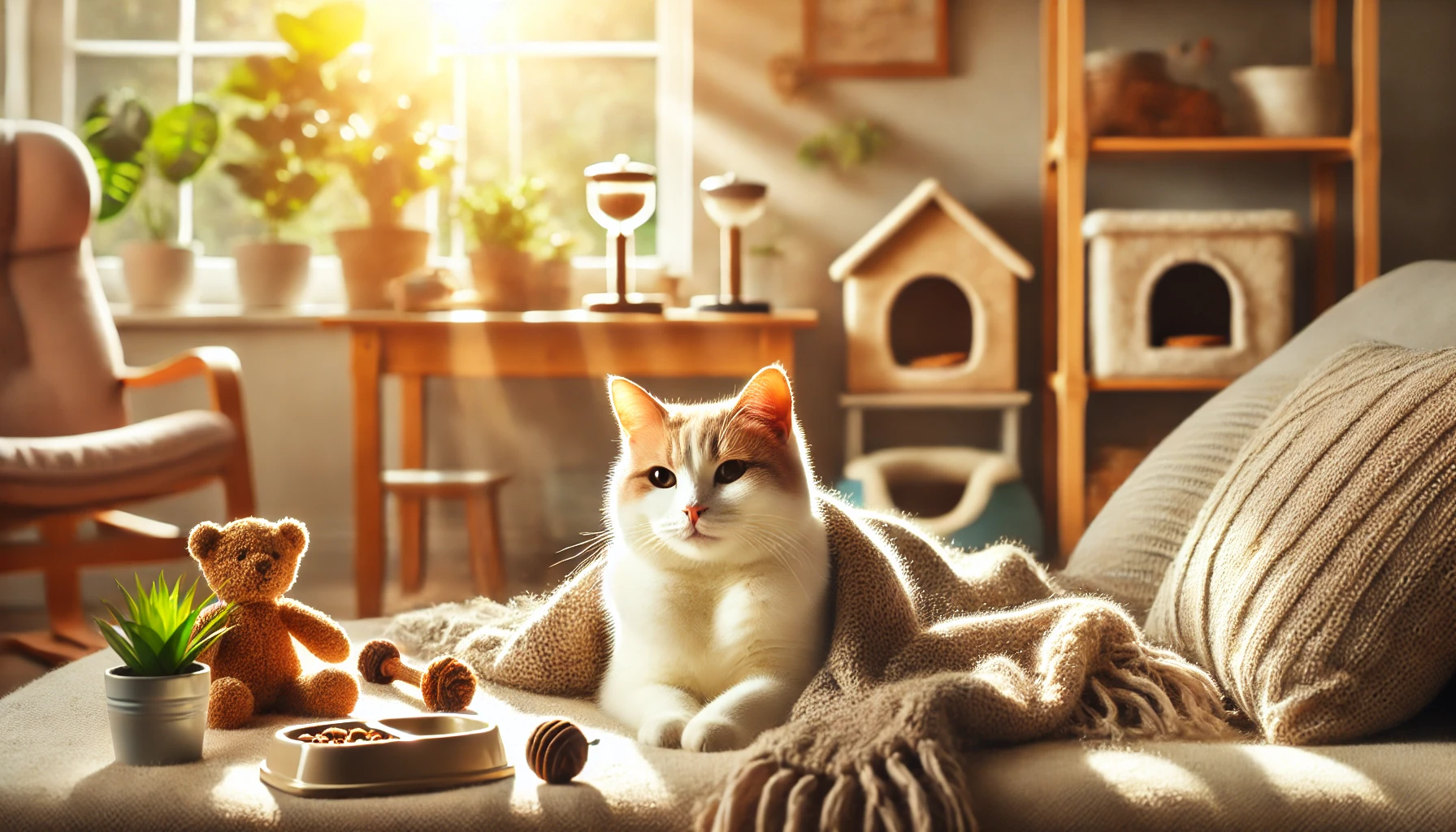
Conclusion
Weight management for cats is a lifelong commitment that involves proper nutrition, sufficient exercise, and regular monitoring.
With the right approach to weight management, you can help your cat lead a healthy, active, and happy life for many years.
By following the tips in this article, you can confidently support your cat in maintaining a healthy weight and preventing complications caused by weight issues.
Success in weight management involves balanced nutrition, regular activity, and consistent monitoring of your cat’s health.
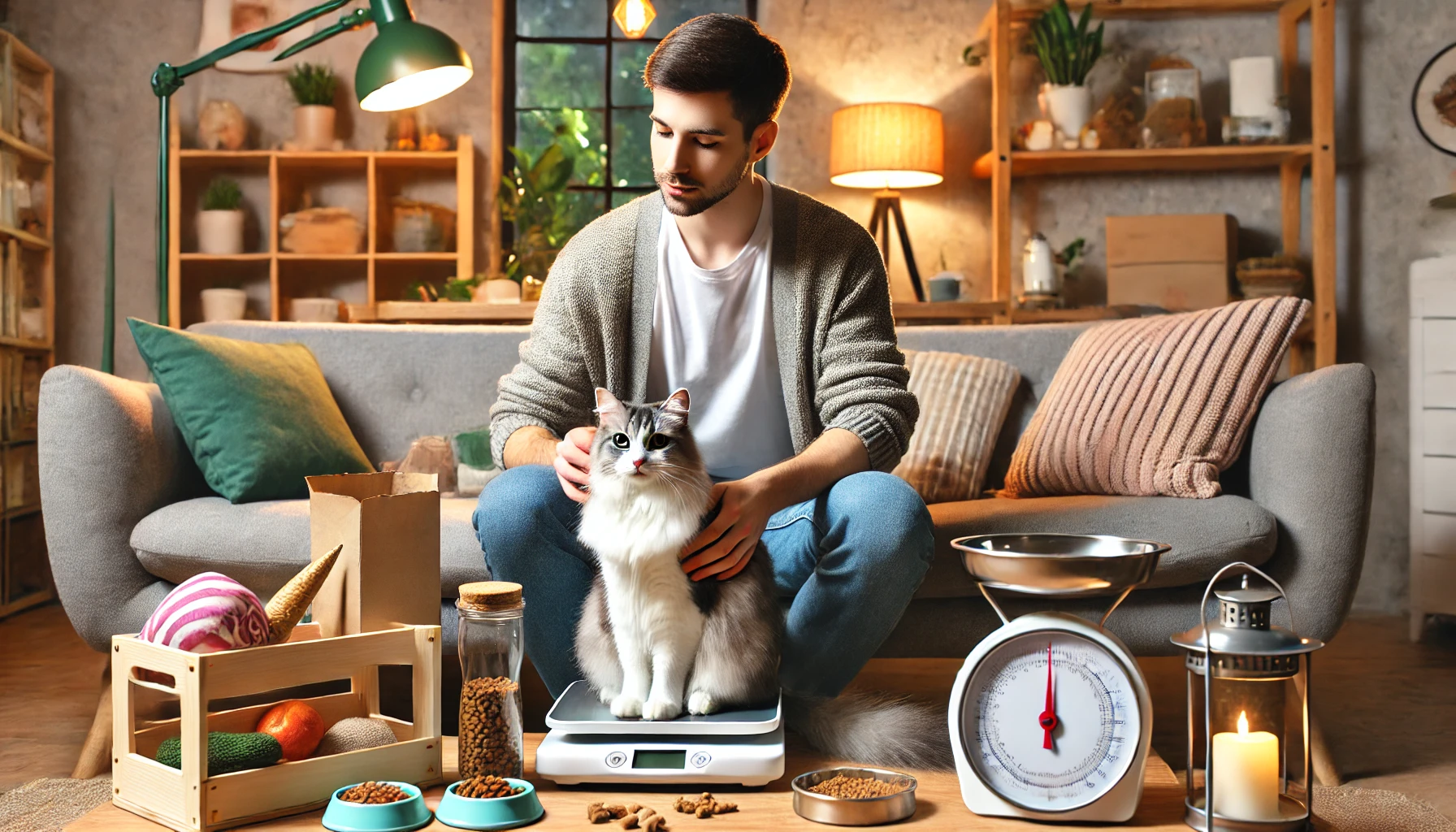
Weight Management for Cats: Frequently Asked Questions
Here are some common questions and answers to help you better understand the best ways to manage your cat’s weight.
How can I tell if my cat is overweight?
You can tell if your cat is overweight by checking for a visible waistline and feeling for their ribs.
If you cannot easily feel the ribs or notice fat deposits on their belly, they might be overweight.
How often should I weigh my cat?
Weigh your cat every 2 to 4 weeks to monitor changes in their weight.
Regular weigh-ins will provide insight into their progress and help you make the necessary adjustments to their diet or exercise routine.
What should I feed my cat for weight management?
Opt for high-quality, protein-rich cat food specifically designed for weight management.
Wet foods with fewer calories and more moisture can also help.
Avoid foods with fillers like grains, and focus on nutrient-dense options that meet your cat’s dietary needs.
How much exercise does my cat need daily?
Your cat should engage in at least 15 to 30 minutes of physical activity each day.
Keep them active with interactive play using toys such as feather wands, laser pointers, or puzzle feeders to help burn off extra calories.
What health risks are there for overweight cats?
Overweight cats are at risk of developing serious health conditions such as diabetes, arthritis, and heart disease.
Excess weight puts additional strain on their joints, making movement difficult and reducing their quality of life.
Can I give my cat treats while managing their weight?
Treats can be given in moderation.
Choose low-calorie options and limit the amount.
Be mindful of the total calorie count to ensure that treats do not contribute to excess weight gain.
How can I prevent my cat from gaining weight?
Feed your cat pre-measured portions at scheduled times, ensure they get daily exercise, and monitor their weight regularly.
Consulting your vet can also help in keeping your cat at a healthy weight.

